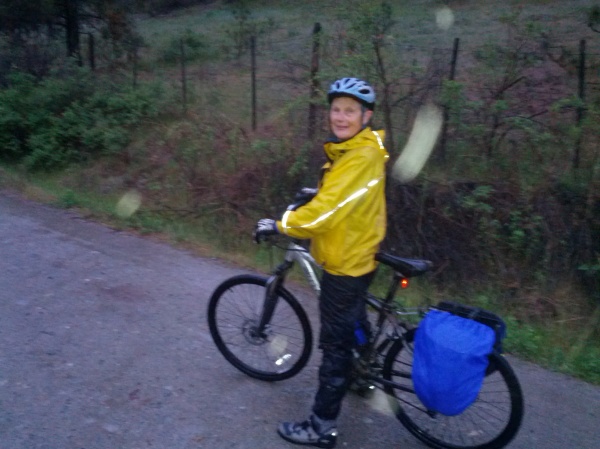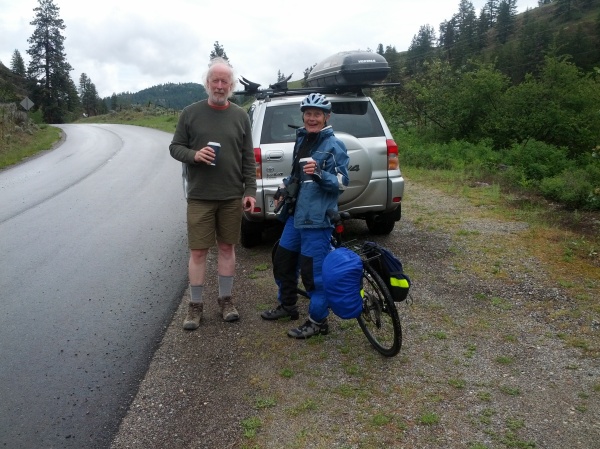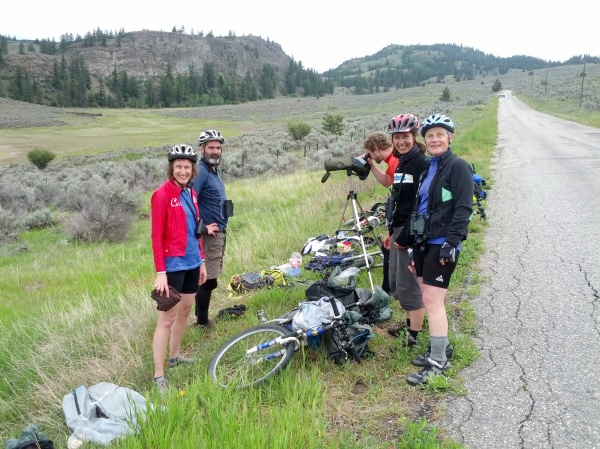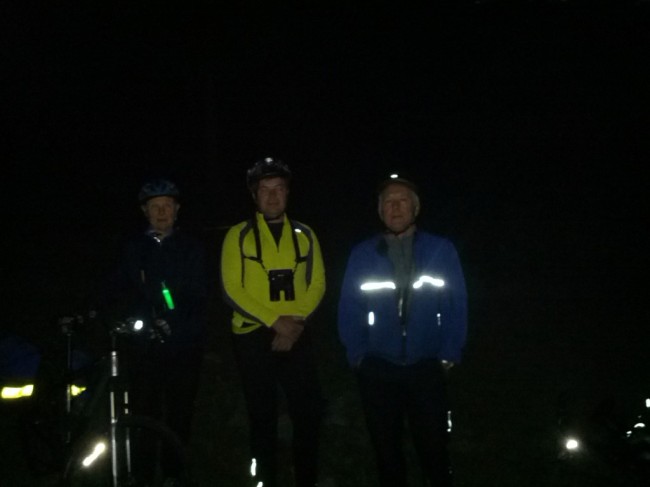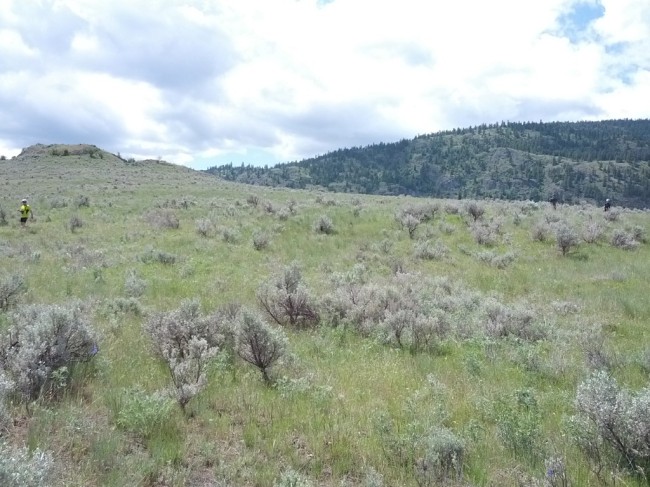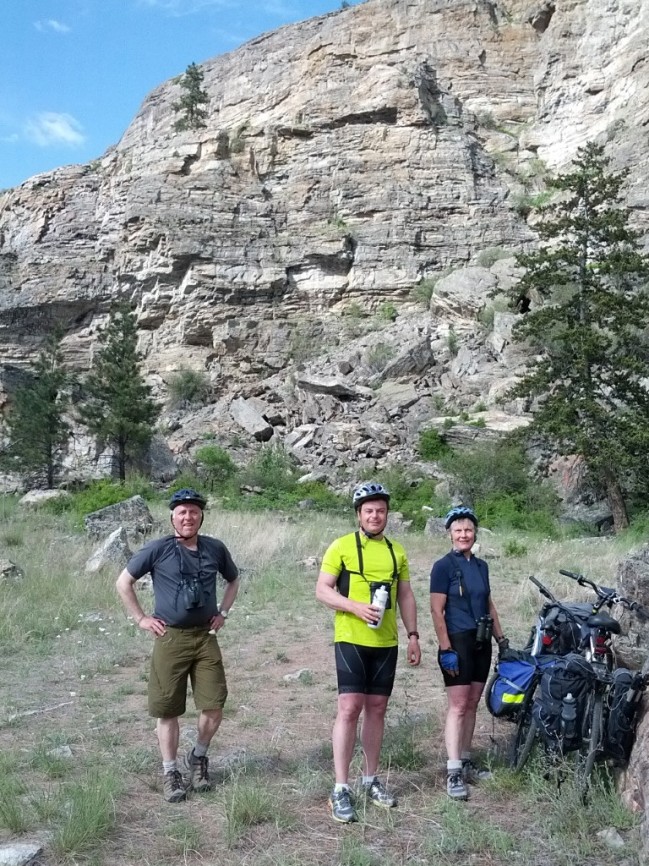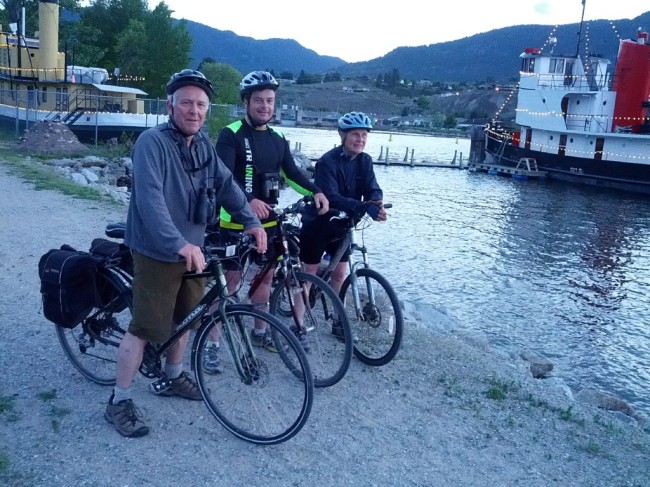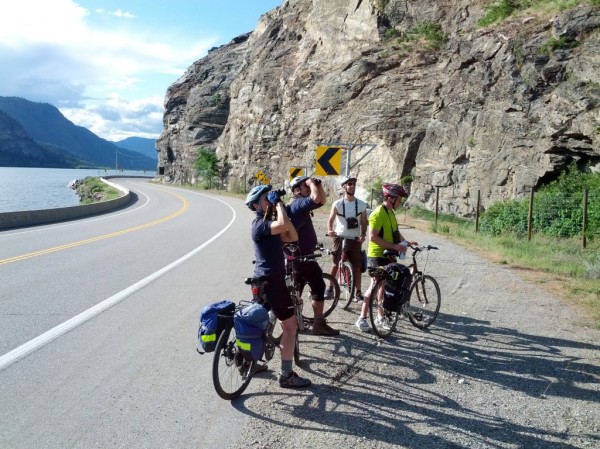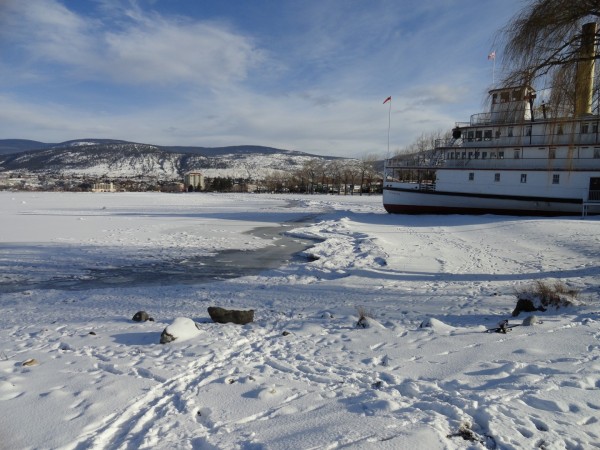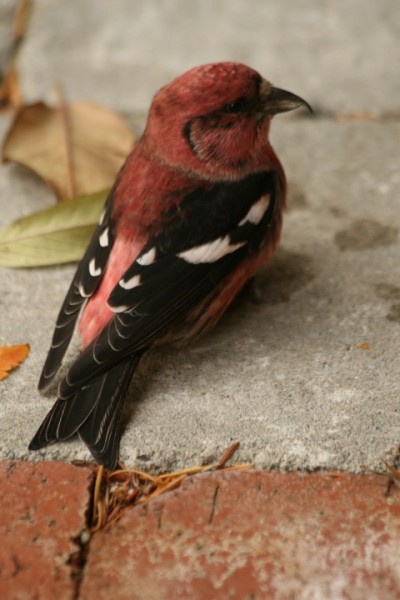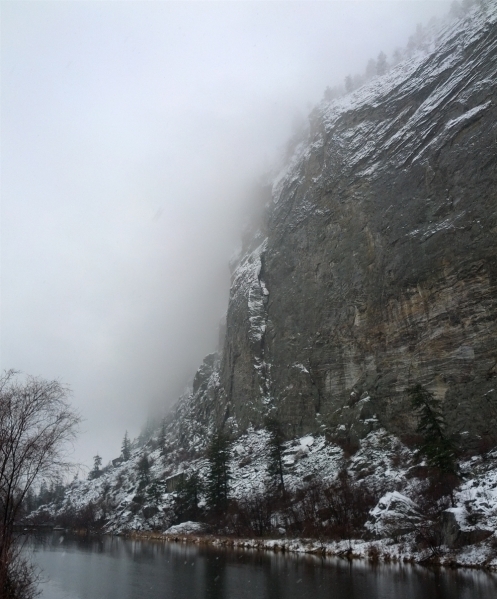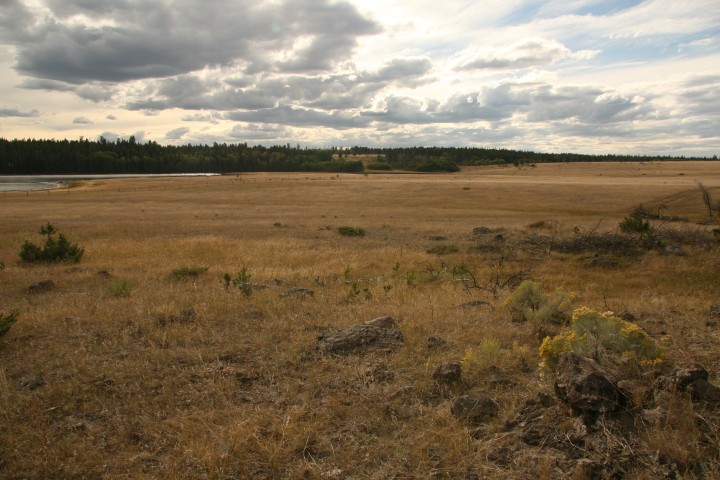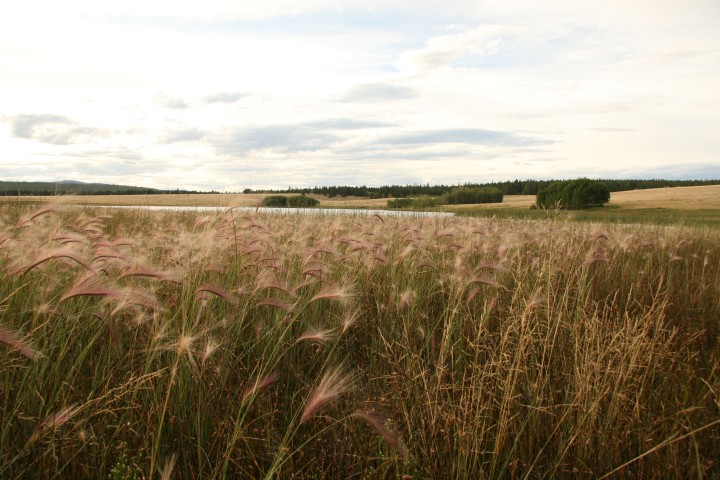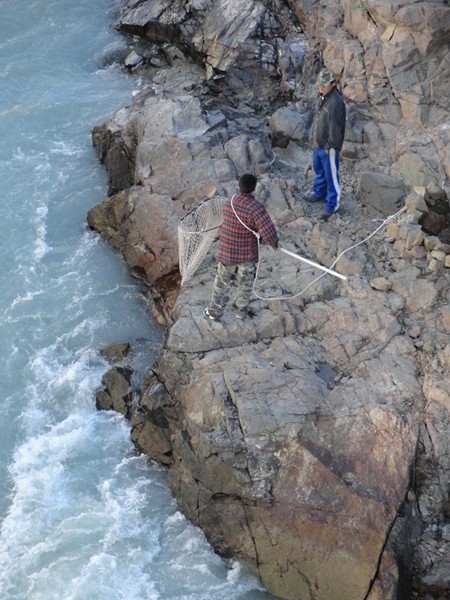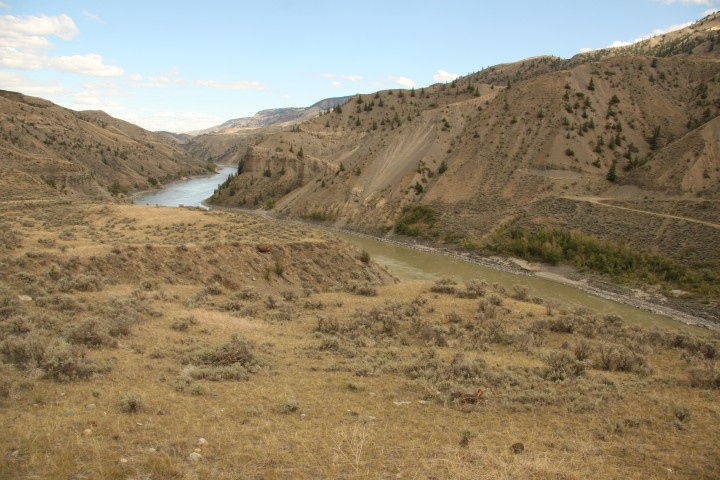Bicycle Birdathon 2021
It’s always a bit of a shock when your alarm goes off at 2:30 a.m. After a moment of complete disorientation, I realized it was B-Day at last, or maybe BB-Day—time for the annual bicycle birdathon. Once awake, the routine was familiar—coffee, toast, many layers of cycling gear, last minute checks for binoculars and other essential items. But this year was different—for the first time I’d be doing my birdathon alone. Eva Durance, my long-time cycling and birding companion, had decided to do something a little shorter and flatter this year, and a couple of friends from the coast couldn’t take part because of travel restrictions in BC due to COVID.

Despite having no-one to meet up with, I did get myself out the door on time at 3 a.m. and cycled off into the darkness. Happily, it wasn’t raining as it had been the last two years and the temperature was a balmy 12C. I sweated up the hill to Max Lake, adding a couple of the usual middle-of-the-night songbirds on the way—Violet-green Swallow and American Robin. As I got to Max Lake itself a Great Horned Owl hooted from Husula Highlands and a Spotted Sandpiper piped from the other side of the marsh.
I was hoping to hear the grunting calls of a Virginia Rail as I had the last few visits to Max Lake, but instead a Sora called, then a Song Sparrow. Farther up the valley, a Common Poorwill flushed off the road and began calling from the pine woods nearby; I would see and hear a number of these as I continued up into the hills.
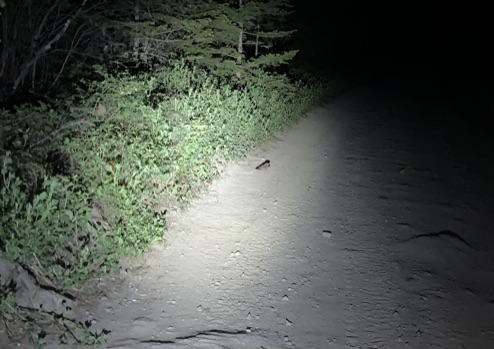
My first real task of the day was to find the Western Screech-Owl that had been so vocal beyond the marsh, but despite my best attempts at whistling like a bouncing ball, there was simply silence. I kept pedalling up the rough road to the end, where a Flammulated Owl called in the distance (or maybe it was close by—hard to tell with those guys). I tried again for screech-owl, since there had been one calling here as well in recent weeks. Silence. I whistled like a pygmy-owl, hoping to nudge the one that has literally been calling here all spring. More silence. Time for coffee.
I settled down on a big stump and immediately heard, or rather felt, the deep thumping of a Ruffed Grouse, beating its wings on a nearby log. A Townsend’s Solitaire sang from the pines upslope, then a Veery called. It was the start of the dawn chorus, time to turn my attention to songbirds and slowly make my way downhill.
The species come thick and fast after 4:30 a.m.–Wilson’s Warbler, Spotted Towhee, Red-breasted Nuthatch, Dark-eyed Junco, Mountain Chickadee, Northern Flicker, Black-headed Grosbeak, California Quail. This is the time of day that species are accidentally left off lists and have to be sorted out the next day! By 5 a.m. I had 20 species.
By the time I was back to the marshy shores of Max Lake, I’d added Warbling Vireo, Black-capped Chickadee, Brown-headed Cowbird, and a pleasant surprise—my first Willow Flycatcher of the year. A Pied-billed Grebe gave its bizarre call from the centre of the pond and a coot cackled. More songbirds piped up—Dusky Flycatcher, Western Wood-Pewee, Cassin’s Vireo, House Wren. I heard the stuttering finish of a Rufous Hummingbird display overhead.
I only had 34 species at 5:30 (I prefer to be at 50 by then) but it was time to get back home to get sorted for the long day ahead. The rural suburbs of the West Bench provided new habitat and a very quick boost to the species list—Northern Rough-winged Swallow, Say’s Phoebe, Eurasian Collared-Dove, Pine Siskin, Brewer’s Blackbird, Evening Grosbeak, Western Meadowlark, and more. As I turned into my driveway at 6 a.m. a pheasant called: species #50.
After another coffee and a wardrobe shift to warmer temperatures, I saddled up again was off down the hill to the KVR rail trail. Steller’s Jays said goodbye at my driveway and a Clark’s Nutcracker called from my neighbour’s pines. A Lazuli Bunting sang as I entered the dry grasslands, and Bank Swallows chattered at their colony. I quickly tallied a Yellow-breasted Chat, one of a growing population in the rose thickets below, and then a Bewick’s Wren, another species growing in numbers in the Okanagan.
I saw a group of four birders walking the trail toward me and recognized them as Bishop’s Army, one of the other teams taking part in the Okanagan Big Day Challenge. They provided the biggest surprise of the day—photographic evidence of not one, not two, but a flock of 80 White-faced Ibis! Apparently the birds were flying south over Penticton only a half-hour before. I spent the rest of the day looking up in vain.
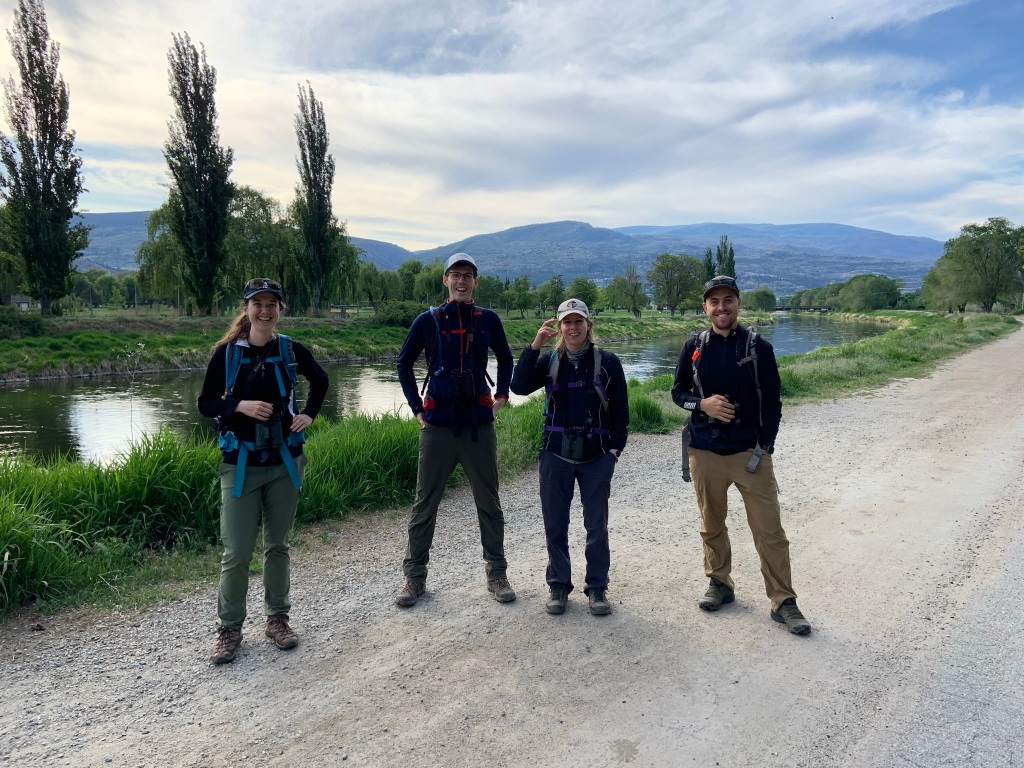
I reached the Okanagan River Channel and turned north. A Great Blue Heron flew overhead, then I heard the sputtering chatter of my first Eastern Kingbird of the year. A singing Gray Catbird was also my first record of the year—this species can be easily missed on long May weekends that happen a few days earlier in the calendar.
By the time I reached the southwest corner of Okanagan Lake it was 7:15 and I had 68 species. The lake added Common Merganser, Horned Grebe, Red-necked Grebe and Western Grebe, but not a single gull to be seen. Happy with the grebes but disappointed in being gull-less, I turned around and headed back down the river to begin the big southward trek of the day.
My spirits were quickly buoyed by the “chebek-chebek-chebek” of a Least Flycatcher calling from the cottonwoods, then a Wood Duck flew over. A half-dozen Turkey Vultures perched in a big dead cottonwood, waiting for thermals to form. Downriver I added Osprey, Western Kingbird and Black-billed Magpie. The marshy oxbow by the airport held Cinnamon and Blue-winged Teal, the latter my first of the year, but none of the diving ducks that had been there for weeks.
By 8:30 I was at Skaha Lake and the list stood at 80 species, barely respectable according to my cunning plans. Luckily, several Pygmy Nuthatches called and a Yellow-rumped Warbler sang from the pines in Skaha Lake Park, but there were no gulls on the beach. As I started west to climb the Kaleden hill I took one last long look at the lake, hoping to find a Common Loon before the predicted winds kicked up in the afternoon. After scanning the distant waters for a few minutes, I lowered my binoculars to realize that a loon was swimming directly in front of me only a metre offshore. Phew!
The long climb to Kaleden was uneventful and unbirdy—I went over an hour without adding anything new. I turned off the highway onto the White Lake Road and with some relief (it’s a very steep hill!) reached Three Gates Farm, home of my friend Doreen Olson. Doreen was doing a “big sit” at Sickle Point today as part of the birdathon but had thoughtfully left out a pitcher of water so that I could recharge my water bottles. And, of course, there were a few birds attracted to her magnificent garden in the forest—Hammond’s Flycatcher, Red Crossbill and, after a nervous wait, a male Black-chinned Hummingbird.
After a 45-minute break, I was back on the bike continuing up the steepest hill of the ride. A nice surprise was a Gray Flycatcher singing in the open pine forests, the fifth and final Empidonax species I would get. Immediately after that I arrived at a known Lewis’s Woodpecker nest tree, and the birds didn’t disappoint, flying in and calling to make sure I saw them.
Refreshed by those additions I continued up the hill to the point where it levelled off by Saddlehorn Road. There, a Pileated Woodpecker flew silently over the road ahead. Nearby ponds held Green-winged Teal and a Ring-necked Duck. The list was at 92 species, within striking distance of my checkpoint of 100 species by lunch.
At the pond on the south side of the St. Andrews golf course I listened intently for a Virginia Rail to call. They’re always there. But not a peep. A Wilson’s Snipe called though, and a Ruddy Duck gave its bizarre bubbling mating display.
As I reached the open sagebrush grasslands of the White Lake basin my hopes were high for a rapid jump in the species total. A Western Bluebird perched on the wire above its nest, then a Mountain Bluebird doing the same. I bumped into three different Kelowna birders checking out the local specialties, perhaps drawn to the south Okanagan today with the prospect of an ibis hunt. But I was disappointed with the utter silence of sparrows—I ended up missing Brewer’s and Lark Sparrows here.
I set up my scope overlooking the lake and before I could even begin to scan, a Sage Thrasher sang on the slope below me. I breathed a sigh of relief and started to look through the waterbirds, quickly adding Gadwall, Lesser Scaup, Northern Shoveler and Wilson’s Phalarope. The Buffleheads that had been there yesterday were gone. No swifts on the east cliffs. Sparrowless, I decided to cut my losses and move on at 12:30 with 109 species on the list. Because of the numerous gaps in that list, I decided to go to plan B and take the longer route down the Secrest Road to try to fill some of those embarrassing lapses.
As I sailed down the big hill out of the White Lake Basin and into the Park Rill valley, I met up with my main competition in this Challenge—the always-tough Chafing for Chickadees team made up of Kirk Safford, Tanya Luszcz and Lucy Reiss. They were basically doing the same route as mine but in reverse, but I knew their younger legs gave them a distinct advantage. When I told them I was going to Secrest Kirk cryptically said I’d find plenty of sparrows on that route.

At Willowbrook I took a side trip into the east part of that rural area to find the Lincoln’s Sparrow that was singing loudly yesterday. No luck. I continued south through the Meyer’s Flat cienega and was relieved to have a few chattering White-throated Swifts rocket overhead. I turned left onto Secrest, my ears on the alert for White-breasted Nuthatch calls but heard only Pygmy Nuthatches. Oh, and a Hairy Woodpecker!

I popped in to visit Marianne and Kurt Hutterli, since they usually have a White-breasted Nuthatch nesting under the eaves of their house, but alas, apparently Violet-green Swallows had taken over this year. Then it was down the big Secrest hill (always nicer going down this than up!) and into the Hack’s Pond area at the bottom. This had to be where I’d find a couple of new sparrows, but no luck once again. The pond itself is one of the best places to find Virginia Rails along my route, but complete silence on that front.
I was beginning to suffer the mid-afternoon blues that often take over on birdathons as it gets harder to add new species and each miss is a tough disappointment. I stopped in at the gas station to get some fluids and quickly felt better, especially when a Vaux’s Swift squeaked overhead. At McIntyre Bluff I spent some time gazing up at the massive 300-m high (1000-ft) cliff to scan for Peregrine Falcons. I’d seen one there the day before, but it requires some luck to have one show itself at those distances, and that luck was apparently not with me.
I was soon at Vaseux Lake and another opportunity to add some waterfowl and other wetland species. My other need here was Canyon Wren and Rock Wren on the dry cliffs. I scanned the south end of the lake and saw only geese, and tried to whistle up a Canyon Wren with my chapped lips. Silence. Farther up the lake I spotted a flock of ducks in the distance that proved to be mainly Redheads and suddenly a Canyon Wren began singing behind me with no urging from my lisping whistles. A couple of Bonaparte’s Gulls flew up the west side of the lake. Things were looking up.
At the north end of the lake I walked out on the brand new boardwalk to the bird blind (certainly one of the finest boardwalk/blind combinations in the country!) and was relieved to hear the chatter of a Marsh Wren and the sight of a single American Wigeon in with some Redheads. No Virginia Rail, no Downy Woodpecker. The forecast winds were kicking up now, gusting to 50 km/hr out of the north, right into my face for the 30-km ride home.
On my way back on the boardwalk I met Dan Albas, one of my MP colleagues who represents the riding of Central Okanagan-Similkameen-Nicola. We chatted a bit about Bill C-12, the Climate Accountability Act, that is in committee hearings right now, and then his wife Tara said “Did you see the Bald Eagle?” That snapped me out of political talk and politely bid them farewell to get out of the woods and look for soaring eagles.
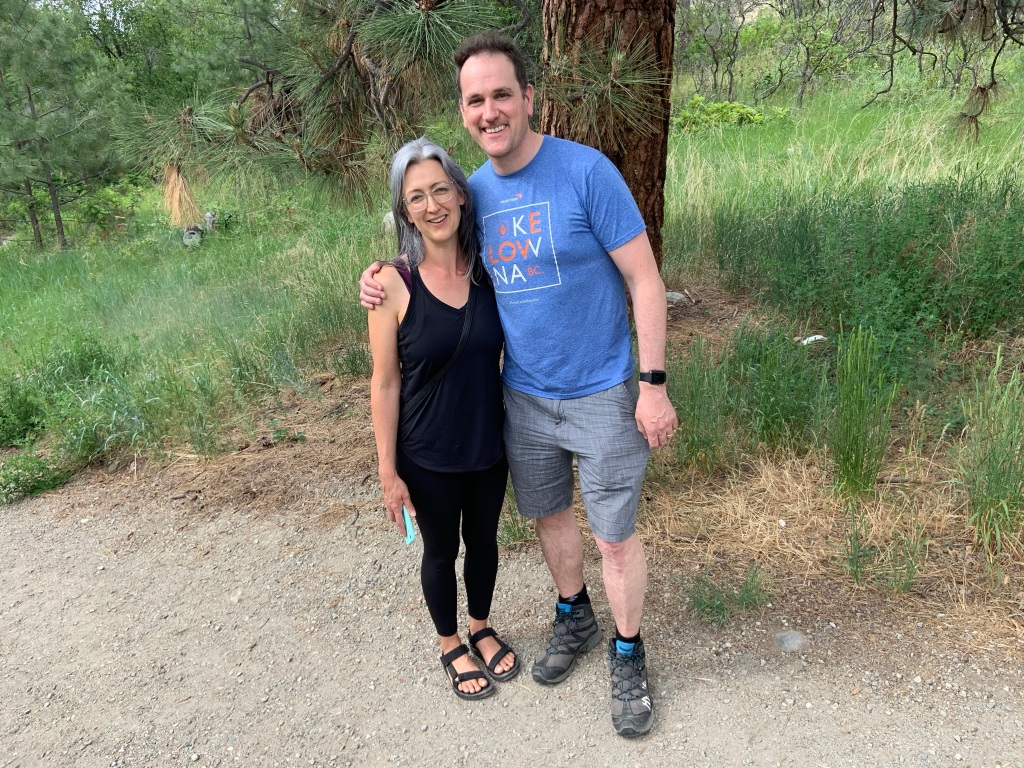
I cycled north up the highway to the Vaseux Lake Bird Observatory site, where, lo and behold, there sat the Bald Eagle on a big pine. I walked into the site and immediately heard a Virginia Rail calling from the marshy oxbow. Phew! A Bewick’s Wren sang as well—something they never do when I need them at this time of the day.
It was 5 pm and time to start the homeward stretch. I stopped to scan the big marsh for Yellow-headed Blackbird—success at last! As I got on the KVR Southern Spur trail in Okanagan Falls a Belted Kingfisher flew in, calling loudly. Voila!—species number 120. My list was officially respectable if not in a winning position. Cycling against the wind along the west side of Skaha Lake, I was pleasantly surprised to see a couple of brilliantly lit male Greater Scaups close to shore.
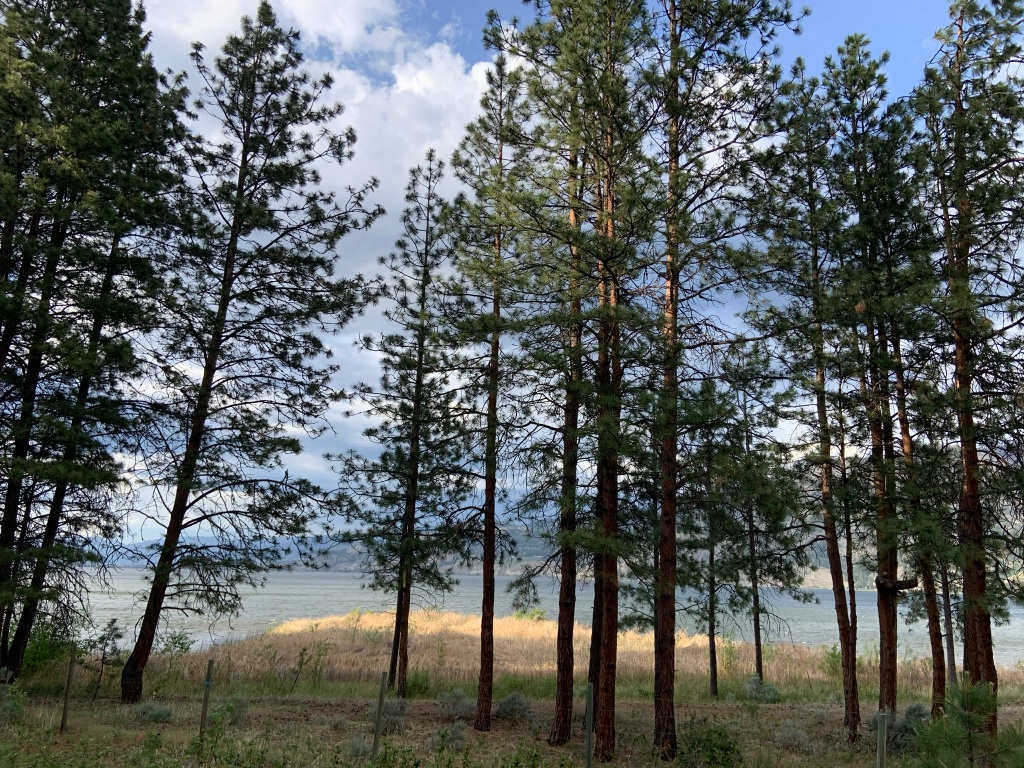
I passed by Sickle Point, a beautiful little patch of riparian woodland and wetland that had recently been purchased for conservation after a strong community campaign. I was hoping that Doreen Olson and Glenda Ross would still be there on their “big sit” but they’d obviously packed it in for the day. As I reached the north end of the lake, I had to decide whether to take the Old Airport Road to look for sparrows or go up the river channel. Feeling that the wind would make it difficult to find sparrows (and generally feeling let down by sparrows all day), I chose the river channel. I was rewarded with an American Kestrel (at last!) but no new waterfowl on the oxbows. No ibis either.
At Okanagan Lake I made one final scan for a gull, any gull, but the wave-washed beach was bare of birds. I turned homeward and pumped up the West Bench Hill and was home by 8:35, with 107 km behind me and 122 species on the list.
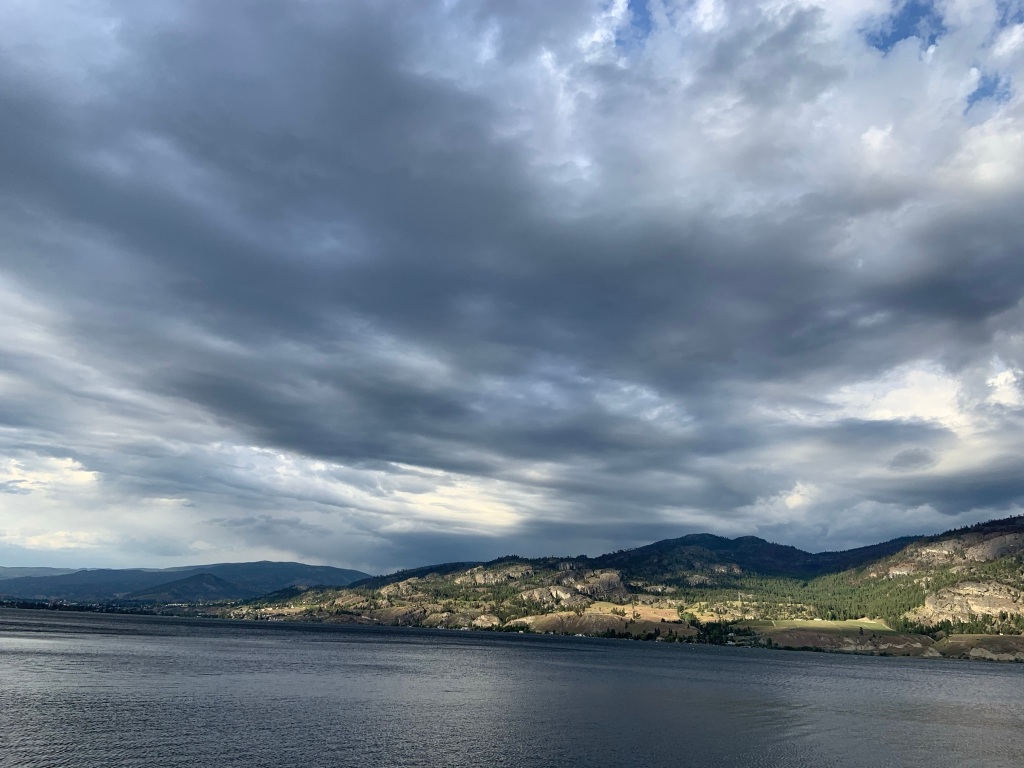
The next morning, we had the traditional Okanagan Big Day Challenge brunch, held for the second year in a row over Zoom. Thirty-seven people had taken part and many stories were told! As I feared, the Chafing for Chickadees team had prevailed with 125 species for the overall trophies, thanks to their superior effort and good fortune with sparrows. But everyone agreed it was one of the nicest days for the event and a great way to raise funds for the Vaseux Lake Bird Observatory. Until next year!
Bicycle Birdathon 2020
All week we’d been looking at the forecast for rain on Sunday, May 17th, the day of the 35th annual Okanagan Big Day Challenge, now part of the Great Canadian Birdathon. All week I kept thinking that the forecast would change—there’s no way that even smart meteorologists can predict the weather so many days in advance, and the weather had been so fine for weeks. But the forecast stuck, day after day. When the alarm went off at 2:30 a.m. my first thought was “Is it raining?” The sound of steady drizzle outside came as a quick answer. The weather people had been right all along.

I phoned Eva Durance, the other member of team CORVID 19, and suggested that we until the rain let up. At 3:24 I gave up waiting and off I went into the wet darkness. For the first time since we started using this route, there were no birds calling as I cycled up to the Max Lake Road. Our first bird was a Song Sparrow at Max Lake, followed quickly by the bizarre calls of the resident pair of Pied-billed Grebes. Some Violet-green Swallows twittered overhead, and then a Common Poorwill flushed off the road.
As we neared the end of the track, a Flammulated Owl called three or four times from the steep hillside—a big relief in the spitting rain! Dawn chorus was already slowly beginning in the gloom, and we quickly added Spotted Towhee, Townsend’s Solitaire, Hammond’s and Dusky Flycatchers, Western Tanager, Black-headed Grosbeak and more. A Barrow’s Goldeneye, probably a bird breeding on one of the ponds up Blue Mountain to the south, circled overhead quacking and its wings whistling. Then a Veery called, the first of the year, and a singing MacGillivray’s Warbler was a bit of a bonus. The big disappointment was the lack of a Northern Pygmy-Owl, considering I had heard one hear every time I visited this spring.
At Max Lake itself a Virginia Rail called loudly, followed immediately by the whinny of a Sora. With only 40 species on the list as we left the Max Lake Road, we were about 10 behind normal pace, but added Say’s Phoebe, Western Kingbird, and Western Meadowlark in the remnant grasslands on the way back to the West Bench rural suburbs. By the time we got back to my house at 06:15 we were in steady rain again, but had caught up a bit in the species total with 54.
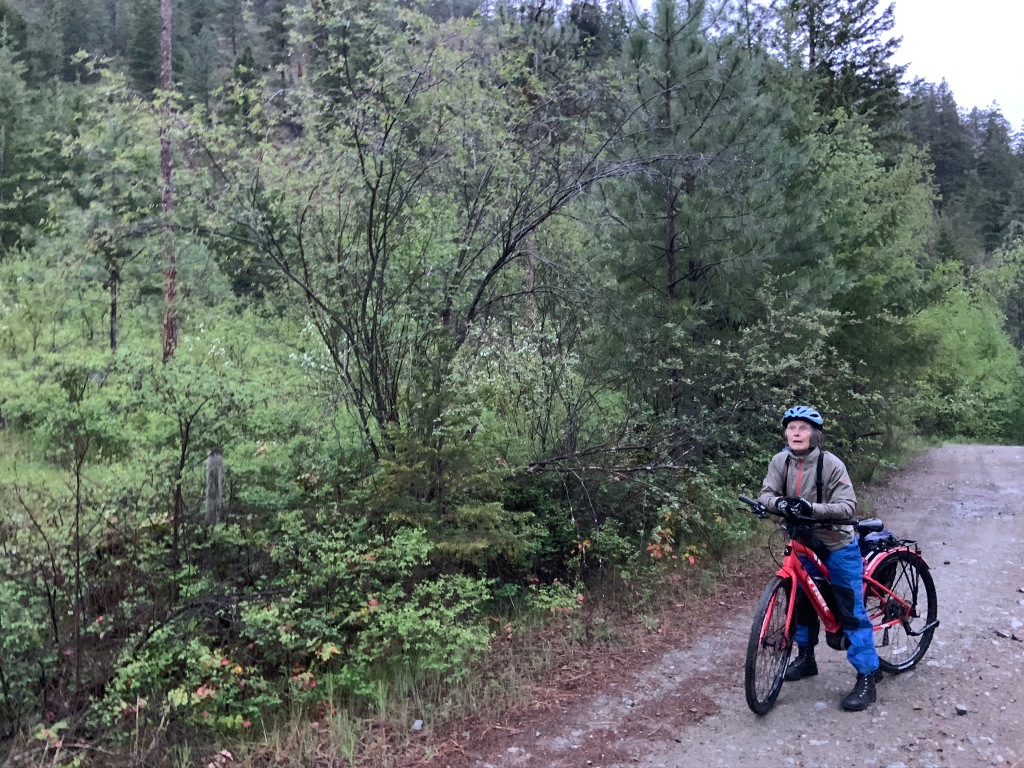
Calliope and Rufous Hummingbirds buzzed around the feeders and the local gang of Cassin’s Finches fed on sunflower seeds. The Red-breasted Nuthatch popped out of its nest. We took advantage of the opportunity to throw our outer layers into the dryer and made some fresh coffee and a quick breakfast. As we left the house at 06:50 we added Wilson’s Warbler, Evening Grosbeak and a surprise Great Blue Heron flyover. We sailed down the hill and onto the rail trail to the Okanagan River channel. Yellow-breasted Chats and Lazuli Buntings sang on both sides of the trail.
We turned north at the river and cycled to Okanagan Lake at the SS Sicamous. The rain had stopped and the lake was glassy smooth. And empty. Desperate, I dug out the scope and found a single loon along the eastern shoreline—species 74 at 07:40. Turning south, we headed back down the river as the rain began again, this time quite heavy. We were hoping for Belted Kingfisher, Northern Harrier and Blue-winged Teal, but had to settle for Vaux’s Swift, Yellow-headed Blackbird and Pygmy Nuthatch.
Skaha Lake, which often provides a wealth of waterbirds, was as empty as Okanagan Lake except for a couple of Common Mergansers. The rain clouds began to lift but the showers continued, even after the sun came out at Kaleden. At the highway lookout above Skaha I talked to a woman who was waiting for the arrival of the Snowbirds; I remember thinking later in the morning that we never did hear them roar by but didn’t hear of the Kamloops tragedy until I got home.
The Kaleden hill is about 9 km of steady highway uphill, and I was sweating in the humid sunshowers. There were a few gaps in the traffic, thanks perhaps to the COVID crisis keeping people at home on this holiday weekend, so we actually could hear birds on occasion. Eva was way ahead of me on her e-bike (though I found out later I couldn’t even keep up with her when she was using her regular bike), so we missed a couple of sightings—I had a Lark Sparrow and she had heard a Ruby-crowned Kinglet.
We turned right onto the White Lake Road and began the steeper climb to Three Gates Farm, where our friend Doreen Olson has always provided water, coffee and good birds. By the time I got there Eva had already seen a White-breasted Nuthatch at the feeder, but I one-upped her when I saw two Black-chinned Hummingbirds while she was inside. Doreen’s big contribution this year was a Northern Saw-whet Owl nest in a box along her driveway and a Western Screech-Owl nest in a box down by the creek. Since I’d put up both of those boxes many years ago I feel good every time I see them used.
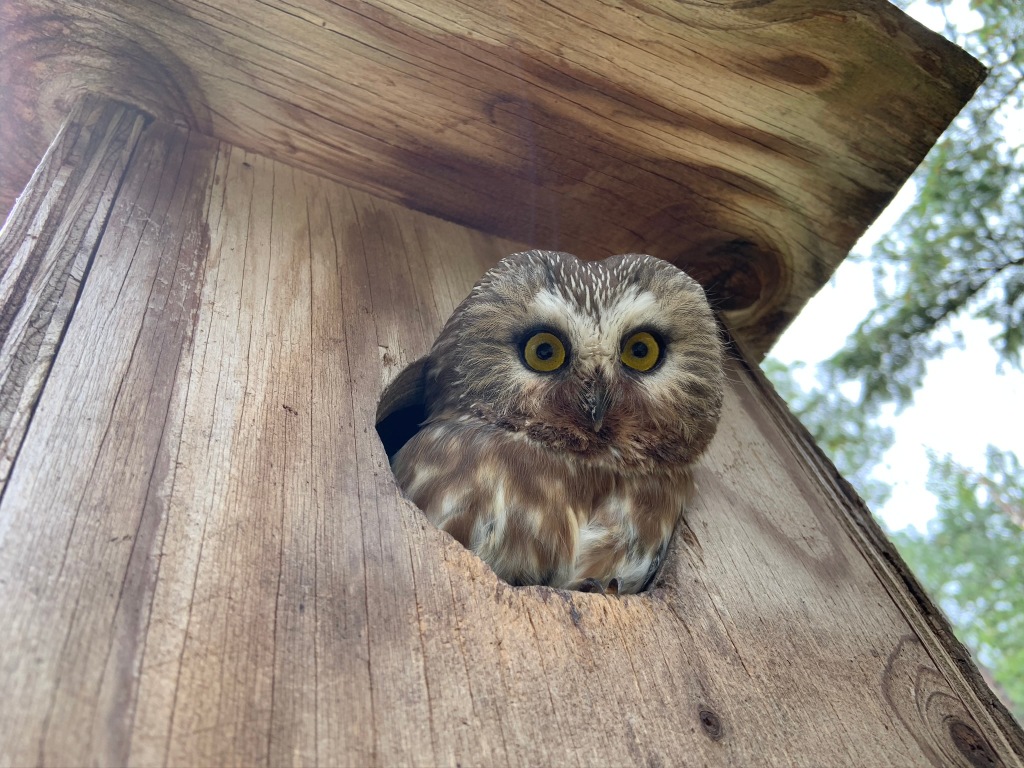
We were tempted to spend the rest of the day in Doreen’s garden waiting for an Anna’s Hummingbird to show, but we eventually gave in to reality and continued the steep climb to St. Andrews. A Lewis’s Woodpecker was on its tree this time (we’d missed them last year) and we added Green-winged Teal and Ruddy Duck in the ponds. It was absolutely pouring again when we got a phone call from Chris Charlesworth telling of a Prothonotary Warbler found at Osoyoos Lake by Nathan Earley. “Are you going to go for it?” he asked. I replied that I was on a bike in the middle of a rainstorm and that diversion would add 50 km to an already gruelling day, so no.
The sun came out again as we got to the White Lake basin, and after a few minutes of searching the sage we found a pair of Brewer’s Sparrows, but no Sage Thrasher sang. The lake was fairly empty compared to my last visit, but we did add Cinnamon Teal (species #100!), Northern Shoveler, Hooded Merganser, and, just as we were giving up, three Wilson’s Phalaropes. We left an hour behind schedule at 1:30 pm, tallying the White-throated Swifts chattering overhead as we sailed down the hill into the Park Rill watershed.

I decided to stop at the Willowbrook cattleguard to try for pygmy-owl again—no luck there, but a Rock Wren surprised us with a series of songs from the distant scree slopes. We turned left on to Green Lake Road at Willowbrook and soon met up with the Chafing for Chickadees team coming the other way. We traded laments about rain for a few minutes in the sun, then continued on to Mahoney Lake. There we added Ring-necked Duck and Gray Flycatcher, and just as we were feeling good about that a Pileated Woodpecker called from across the road. I must say that was the best feeling of the day—adding a good bird in the sunshine in the middle of the afternoon doldrums. But it was 5:10 pm and we were losing time and about 50 km from home.
We screamed down the See Ya Later hill (aka the Wall; glad we were going down, not up) to the Vaseux Lake marshes, and crossed the river to the new sewage plant. Some wigeon-like ducks disappeared in flight behind trees, and we didn’t add anything new until we got back on the highway and headed south to Vaseux Lake, when some Lesser Scaup showed themselves in the marsh.
At the lake we added Western Grebe, Red-necked Grebe, Marsh Wren, Common Yellowthroat, Downy Woodpecker and Ring-billed Gull—a nice haul but a few species were decidedly missing. We were at 117 species, so only three away from 120 and some respectability. We reluctantly turned north as time was running out and muscles were beginning to seriously complain. By the time we got onto the KVR south spur trail at Okanagan Falls just before 6 pm, the rain began once again and steadily increased to a decent downpour. We added nothing over the next hour along Skaha Lake and by the time we got to Penticton we were thoroughly soaked once again.
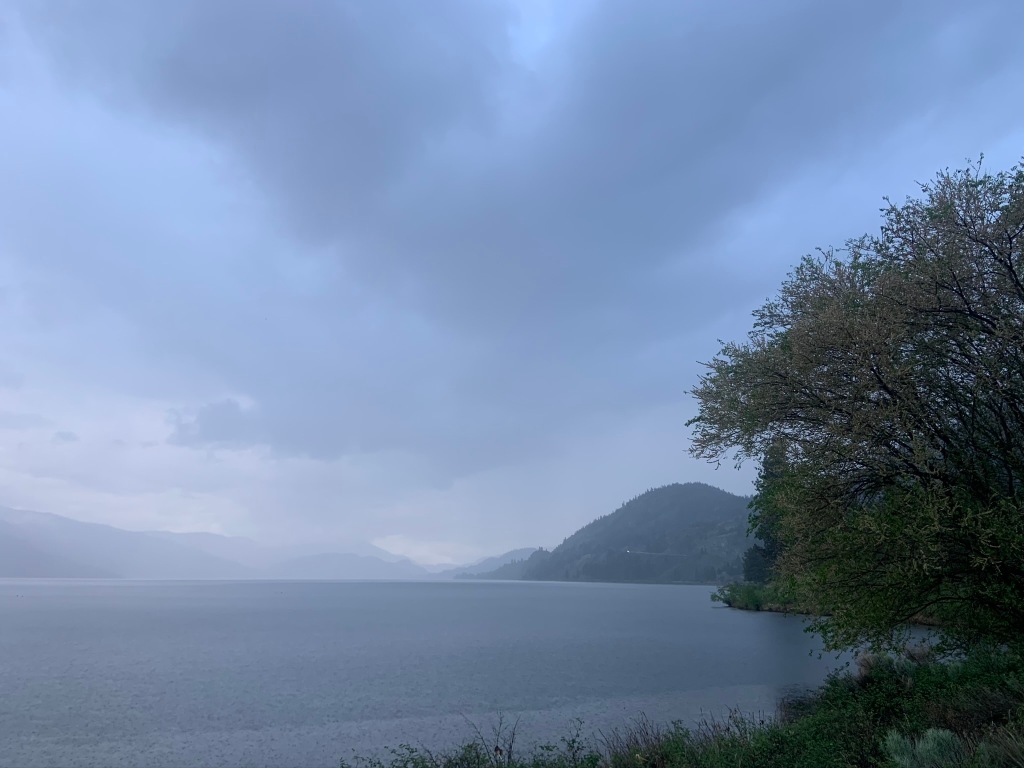
As we cycled north up the river channel we thought we had a good chance for Northern Harrier, Blue-winged Teal and Belted Kingfisher but no such luck (we found out later that the Chickadee team had seen all three only a half-hour ahead of us, sigh). At the north highway bridge, Eva decided to head home up the hill to feed her horses, so I continued on to the lake by myself, hoping for some new waterbird. I met the Chickadees coming the other way, they just said there was nothing on the lake but one gull and it had “flown away”—I later learned it had been a California Gull which would have been new for us. The Chafing for Chickadees said they were going up to Max Lake to try for owls—I wished them luck and was glad that extra climb wasn’t in my plans.
The rain stopped and the lake was calm again when I got there, but absolutely empty. I cycled along the beach promenade to the walking pier and set up the scope for one last search. The plume of Penticton Creek had a Mallard and,… a pair of wigeon! Species 118, our last of the day, at 8:30 pm. I turned back and headed home, climbing the West Bench Hill as the rain started up in earnest. I got home at 9 pm, with 102 km on the odometer for the day.
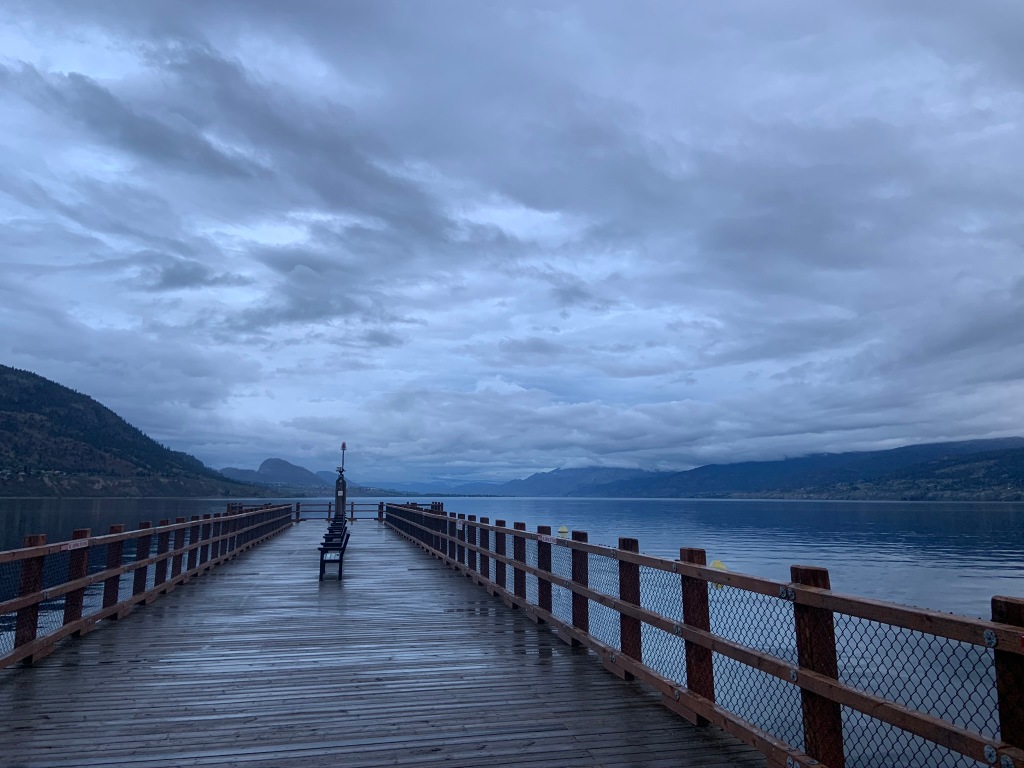
We held a Zoom meeting the next morning at 10 am to hear the stories of the other teams—almost 50 people in all–that had been out on the Challenge. The Chickadees captured the coveted Green Team Trophy for best non-motorized result—they had ended up with 126 species, including a pygmy-owl at Max Lake in the rain. Sigh. But they definitely put in that extra effort. There’s always next year!
Bicycle Birdathon 2019
My alarm jolted me awake at 2:30 a.m. and I immediately jumped out of bed to get dressed for the 2019 version of the Okanagan Big Day Challenge—a birdathon that I’ve been part of since 1986. In the last 15 years or so we’ve been doing this birdathon on bicycles, and this year my teammate would be Martin Gebauer, who last took part in 2011. Eva Durance was to have joined us, but had injured her leg a few days before and had to bow out.
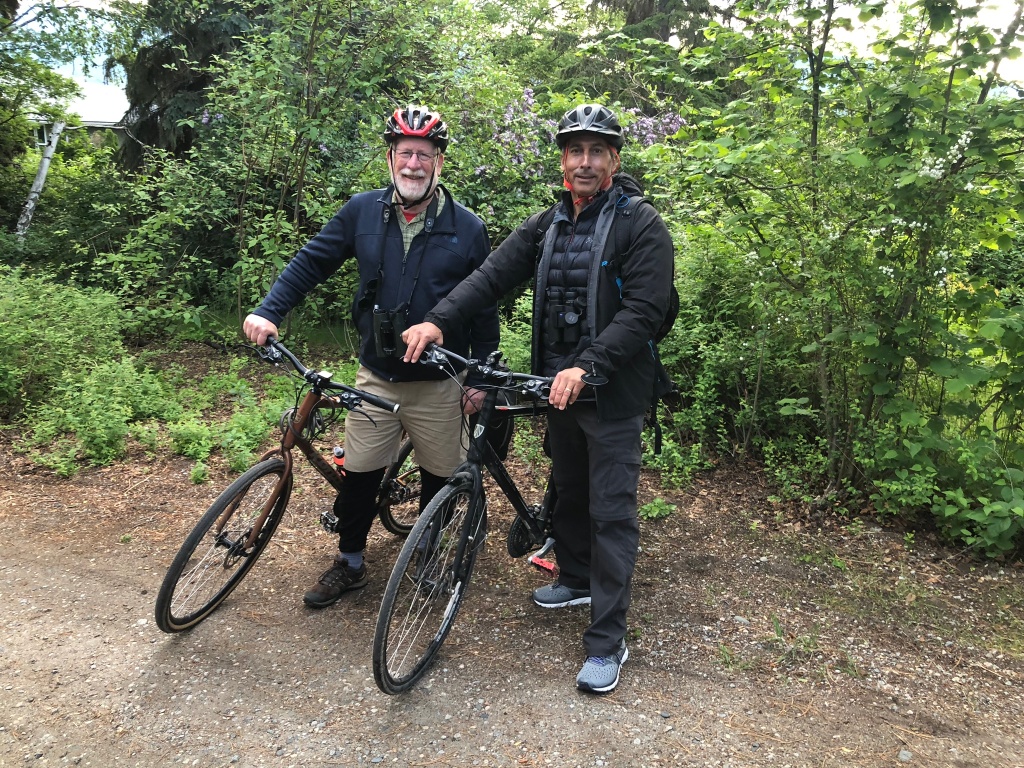
As I got out of bed, my wife Margaret sleepily said, “Did you hear the Great Horned Owl? It was hooting outside the window until five minutes ago.” I quietly pointed out that any bird heard or seen after midnight would count for our list, and please wake me up next time if you hear an owl!
Luckily Martin had heard the owl from the bedroom next to ours, so it becomes species number one. Once on the bikes at 3 a.m., the day began hopefully, almost perfectly—no sign of rain, no wind, and a mild 12℃ showing on the thermometer. We were cycling through the darkness to the Max Lake valley northwest of Penticton. The first hill is always the hardest, and the climb to the hills was tough for my out-of-shape lungs and legs—and there were no birds singing that can be a good excuse to stop during daytime climbs.
But Martin politely matched his pace with mine, and we did add a couple of species before reaching Max Lake—a Killdeer flying overhead and an enthusiastic robin singing in some distant garden. Rails are often the toughest birds to add on this big day challenge, where the rules forbid any use of recordings to lure birds to call. But as we approached Max Lake we could here a very agitated Virginia Rail kiddikking away at some unseen threat. A poorwill called to the full moon as it appeared from behind the clouds. Five species at 3:20.
Owls are often difficult to find at this time of year, again handicapped by the ban on recordings. I was happy to hear a juvenile Great Horned Owl screeching past the lake, part of a brood that had fledged from a nest up the hill in the past two weeks. A sleepy Song Sparrow sang once, and Violet-green Swallows chattered overhead. At 3:40 we heard the first of several Flammulated Owls hooting from the hillside, and the ride up the valley was highlighted by very close-range views of a dozen poorwills sitting on the gravel road surface.
At 4:00 a.m. we reached the end of the road, got off our bikes and lay down in the grass to await the dawn. I whistled my best Northern Saw-whet Owl imitation and was delighted to get immediate tssshk! responses from a couple of fledglings in the nearby trees. Songbirds gradually joined in chorus—Western Tanagers, Chipping Sparrows, Nashville Warblers, Spotted Towhees, Townsend’s Solitaires—and by 4:30 we had 19 species on the list. Martin’s keen ears picked up the OOoop! of a Dusky Grouse high on the ridge to the west.
We got back on the bikes and coasted down the rough road to Max Lake, adding birds all the way—Black-headed Grosbeaks, House Wrens, Steller’s Jays, Mountain Chickadees, Veeries. At the lake a Mallard quacked and a pair of Pied-billed Grebes gave their haunting calls. By 5:30 we had 41 species on the list and were back in the West Bench neighbourhood. The plan was to make a quick stop back at my house to change out of our warmer clothes, grab a quick coffee and be on our way.
Once in the residential gardens we quickly added more species—Say’s Phoebes, Eurasian Collared-Doves, Bullock’s Orioles. A pair of Mountain Bluebirds fed along the roadside and a late Ruby-crowned Kinglet sang from a garden. We were back home at 6:00 with 58 species, including Calliope and Rufous Hummingbirds and Vaux’s Swifts.
By 6:40, only 10 minutes behind schedule, we were sailing down the hill to Penticton and the Okanagan River channel. A Lazuli Bunting and Yellow-breasted Chat sang from the shrubs, two Ring-necked Pheasants rocketed off the side of the trail, Bank and Northern Rough-winged Swallows chattering at their cutbank nests. Martin spotted a pair of Wood Ducks, a Sora called from the oxbow marsh and a Great Blue Heron flew by. This is the exciting part of a big day, when species are added so quickly you always forget to put one or two down.

Once on the river dyke, we turned north for the quick trip to Okanagan Lake. An Eastern Kingbird was a nice surprise along the river—a new arrival from Amazonia, my first of the year. We added waterbirds thick and fast—Common Merganser, Spotted Sandpiper, Red-necked Grebe, Common Loon, Bufflehead, Northern Shoveler. By the time we turned south back along the river we had 76 species.
Riverside bush and wetlands added Common Yellowthroat, a migrant MacGillivray’s Warbler, two Bald Eagles, a pair of Gadwall. We reached Skaha Lake at 8:30—right on time—and 83 species. The lake was disappointingly empty—usually we had a cluster of duck and grebe species here. But we were on schedule, so we started along the highway to Kaleden—and the biggest hill of the day—with high hopes for the rest of the day.
From the highway viewpoint we searched Skaha for waterbirds and did get distant views of a flock of Western Grebes and four California Gulls. Highway birding by bicycle is frustrating at best with the constant traffic noise, but we did add a few birds on that section—American Kestrel, Sharp-shinned Hawk, Pygmy Nuthatch, Red Crossbill, Clark’s Nutcracker. After an hour we’d made it to the White Lake Road junction and turned off the highway and into the hills.
A Red-naped Sapsucker flew in to a roadside tree, and a Cassin’s Vireo sang as we reached the thicker forest. At the top of the first brutal hill we turned off into Three Gates Farm, where our friend Doreen has a bird-filled garden surrounded by diverse forest. We immediately added Black-chinned Hummingbird and White-breasted Nuthatch—both tough species to get some years.
Doreen has had Western Screech-Owls in her nest-boxes several times, so we borrowed her ladder to see if any were in residence this year. The first box, conveniently located by the house, contained only poorwill feathers, so had obviously had an owl in it recently. We hiked down a very steep hill to a second box and were ecstatic to find a female owl with three big nestlings inside. We quickly slipped away to leave them in peace and returned to the idyllic.
There we found Eva, Doreen and Kathryn McCourt doing a “big sit”. We joined them for twenty minutes or so, adding a couple of good species from the comfy chairs—a pair of Anna’s Hummingbirds at the feeders and a Lewis’s Woodpecker on a snag high up the hill to the west.
We reluctantly left Three Gates and continued along the White Lake Road, immediately climbing one of the steepest hills of the day. A small pond at Saddlehorn Drive added Green-winged Teal (species number 100 for the day!), Blue-winged Teal, Barrow’s Goldeneye and American Coot. The marshy pond on the south side of the St. Andrew’s golf course had Ruddy Ducks, but the Wilson’s Snipe that had been so cooperative there yesterday was in hiding.
By noon we were at the big sagebrush basin at White Lake. A pair of Western Bluebirds was an expected addition there, but our search for sparrows proved fruitless. Normally we can find several Brewer’s Sparrows with no trouble at all and often add Grasshopper, Lark and Clay-colored Sparrows. We spent an hour searching for those four species with no luck at all. Luckily a Sage Thrasher sang and gave Martin a quick look, and two Northern Harriers interacted overhead.
Another thing missing from White Lake was any sign of other competing teams—it usually ends up being the lunch stop for some of the biking birders. We wondered if we were missing something somewhere else!
The lake added a few good species as well: Wilson’s and Red-necked Phalarope, Cinnamon Teal, Hooded Merganser, and Redhead. We left White Lake after 1 p.m.—now behind schedule because of our sparrow hunt—with 113 species. We’d hoped to have 120 species at that point, so reassessed our route for the rest of the day. Normally we go south to Secrest and River Roads in north Oliver, but we had most of the species expected on that route. We decided to go through Mahoney Lake and Green Lake to Okanagan Falls and spend more time at Vaseux Lake, so at Willowbrook we turned left.
We immediately encountered the Chafing for Chickadees team that has been our traditional rivals for several years. They admitted to being behind schedule, but you never know what misinformation other teams give you along the trail. A few minutes later we met the youth birding team, who did mention a Lark Sparrow near Green Lake.
At Mahoney Lake we heard several Gray Flycatchers, a welcome relief so late in the day, and a pair of Rind-necked Ducks was a surprise on the lake—they hadn’t been there yesterday. A Hairy Woodpecker called from the ponderosa pines. By now the predicted north wind had pick up and when we got to Green Lake and See Ya Later Ranch we had a tough time listening for Lark Sparrow and gave up on that option quickly. We braked our way down “The Wall”, the steepest cycling hill in the south Okanagan, to the Okanagan River just north of Vaseux Lake. A Yellow-headed Blackbird was in the marsh and a Canyon Wren sang from a roadside cliff.
We crossed the river at one of the weirs and made our way over to the highway just south of Okanagan Falls, turning south to Vaseux Lake. A Cooper’s Hawk flew over the highway—whew! We walked out to the dyke at the banding station, but didn’t find anything new. We went out the boardwalk (Martin dodging the rampant poison ivy to which he is very sensitive!) and got to the blind, hoping to see the Bonaparte’s Gull that was there yesterday. No gull (though we found out later that it had been seen by two other teams earlier in the day) but the Marsh Wrens there got us to a respectable 200 species by 3:40 pm.
At the cliffs we decided not to cycle up the hill but listened at the bottom and eventually heard a single Rock Wren call. It was after 4:00 by now, and time to head north for home. We stopped off at the IGA in Okanagan Falls for a coffee and ended up having a leisurely political conversation with a local.
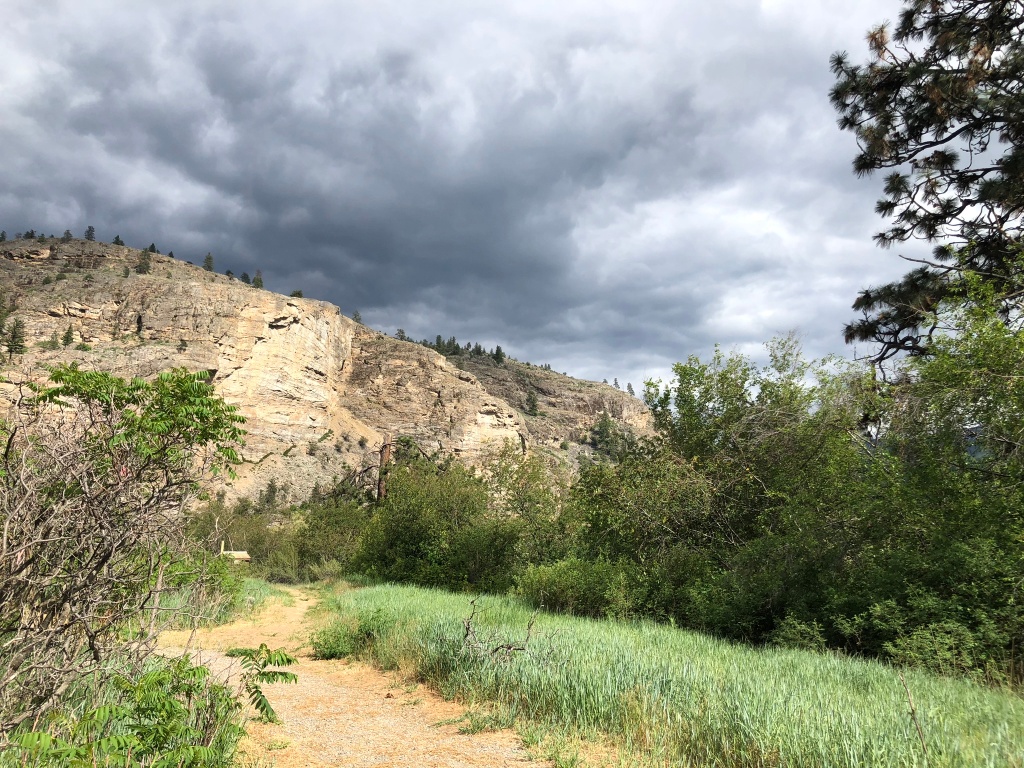
It was after 6 pm by the time we were on the KVR trail on the west side of Skaha Lake. A Ring-billed Gull flying along the lake was species #122, but the rest of the lake didn’t add any new species. I was telling Martin how last year we’d had better luck, stopping to scan the lake and finding Surf Scoters, while a Swainson’s Thrush called from the trail and a flock of pelicans flew overhead. Just as I pointed out that lucky spot, 11 white pelicans glided silently by. One out of three ain’t bad!
At the north end of the lake, we decided to take the Old Airport Road back into Penticton, since it offered a good chance for Lark and Clay-colored Sparrow. The wind had died down and it was a beautiful evening but no sparrows sang. I tried to turn an unusual Lazuli Bunting song into a Lark Sparrow. As we listened at the last meadow that has had Clay-colored Sparrows in the past, Martin heard a high buzzing trill. He was convinced that it was a Grasshopper Sparrow, so we added that bonus species to the list. Eventually we got crippling views of the bird only two metres away!
We ended the day as usual with another trip to Okanagan Lake—and just before we got there a Belted Kingfisher flew by and landed on a sign. It was species #125 at 8:15 pm, and our last addition for the day. We saw the youth birders cycle by, on their way to Max Lake, but we turned for home and a well-earned rest after 105 kilometres in the saddle.
The next morning, all the teams gathered in my garden for the traditional Monday brunch. We found that the youth birders, who had begun their cycling day with a car ride to the high plateaus east of the Okanagan (and thus not eligible for the green team trophy) had tallied 142 species, a remarkable total that gave them the coveted Flammulated Owl Award. Chafing for Chickadees had found 126 species, beating us by one for the green team award. Bird of the Day went to Michelle Hamilton and Grant Halm for a pair of Double-crested Cormorants seen in Kelowna, and the Sour Grapes Award for biggest miss went to the Wilson’s Warblers for finishing the day without seeing a Great Blue Heron. Our team, the Ottawarblers, didn’t get any awards but we had enjoyed the day immensely.
Bicycle Birdathon 2018
The day began before dawn as usual. It was Sunday, May 20th and it looked like the 2018 version of the Okanagan Big Day Challenge and the Great Canadian Birdathon was blessed with perfect weather. One of my team members, Liron Gertsman, cycled up my driveway just before 3 a.m. and we were off in the darkness to meet Eva Durance at our first stop—Max Lake.
We were planning to cycle through the south Okanagan, counting birds and raising money for the Vaseux Lake Bird Observatory. And getting in shape. I usually do some training on the bike before this event, but my present lifestyle makes that a bit difficult, so had some trepidation about my stamina this time. At any rate, I knew it would be fun, as all the birdathons I’ve done have been.
The first few birds in the dark are always fun to check off—we started with a meadowlark singing just as we got on the bikes, then more song from a Chipping Sparrow and robin along West Bench Drive. We powered up the steep hill to the start of Max Lake Road and saw Eva’s headlamp bobbing through the grasslands toward us. A couple of Violet-green Swallows chattered above us—four species by 3:20 a.m.!
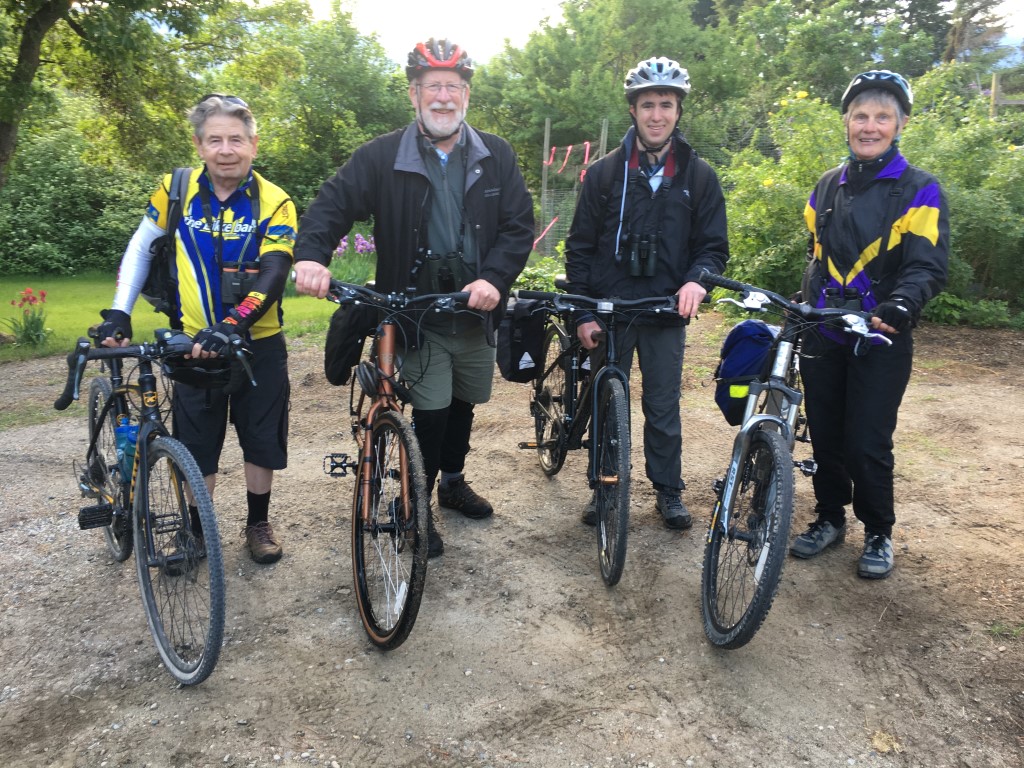
We cycled through deep water in the giant potholes of Max Lake Road, fed by a brand-new creek that took up the left side of the road, a creek that was draining the flooding waters of Max Lake itself. Normally a shallow marsh, the lake was actually a lake this spring. A catbird sang from the thickets and a California Quail called from somewhere in the hills, then we heard the first of many poorwills calling from the pines. A Sora whinnied from the marsh, but no Virginia Rail.
Beyond the lake we added a Western Tanager giving its br-dik call from the dark forests and got our feet wet in some very deep waters on the road. We saw several poorwills along the road—one of which I almost ran over before it flushed. Finally a Flammulated Owl called from the high ridge above us—the real Max Lake specialty that we were here before dawn to get on our list. Then another. A Ruffed Grouse drummed close by—luckily Eva and Liron could draw my attention to it because I have real trouble with very low sounds. A Spotted Towhee song made it an even 10 species by 4 a.m.
Fifteen minutes later the real dawn chorus began, and we started listing species one after another—Nashville Warbler, Black-headed Grosbeak, Townsend’s Solitaire, Veery, Mourning Dove, Mountain Chickadee, Dusky Flycatcher, Dark-eyed Junco, Cassin’s Vireo, Cassin’s Finch. At 5:00 a.m. the floodgates of birdsong really opened up as we turned around and headed back down the road, and by the time we got back to my house at 6 a.m. we had a very respectable 60 species. The best addition was a late migrant Ruby-crowned Kinglet singing loudly from a neighbour’s garden.

After putting on dry socks and gulping down the last of the coffee, we welcomed the last addition to the team, Peter Maser, who met us just as we set off down the hill to the Okanagan River. The species kept coming—Lazuli Bunting and Black-billed Magpie along the KVR and several Yellow-breasted Chats singing from the rose thickets on the flats below. An Eastern Kingbird, just back from South America, chattered along the riverbank.
At the Okanagan River dam at the south end of Okanagan Lake we added Spotted Sandpiper and another bonus bird, MacGillivray’s Warbler. Red-necked and Western Grebes on the lake made it an even 70 species by 7:30. No loon, no kingfisher—we’d have to keep looking for those. We turned south down the river, adding Turkey Vulture, American Kestrel, Great Blue Heron and Osprey. A single Redhead on the airport oxbow pond was disappointing—normally a good variety of ducks are there, though a male Hooded Merganser was nice.
By 8:30 we were at Skaha Lake and the first real excitement of the day—a big flock of gulls on the sandbar and a veritable field guide page of ducks feeding amidst the floodwater debris out in the lake. Four species of gull, including Glaucous-winged, were on the bar, and Lesser Scaup, Blue-winged and Cinnamon Teal, Ruddy Duck, Northern Shoveler, Wood Duck, American Wigeon and Gadwall pretty much filled in the duck part of the checklist. Ninety-five species and we were definitely on track for a good day.

Then came the big climb of the day—up the long Kaleden hill on the highway, more climbing to the White Lake Road, and some steep climbs to the height of land above that. A Rock Wren and Sharp-shinned Hawk gave us good excuses to catch our breath along the way. By 10 a.m. we turned into Doreen Olson’s driveway at Three Gates Farm—Doreen was just leaving but had left us water to recharge our supplies.
Doreen has a fabulous property for birds, and the obvious highlight for us was a Western Screech-Owl nest. Hammond’s Flycatchers sang, Red Crossbills called overhead and we were happy to get a couple of Black-chinned Hummingbirds, our third hummer species of the day. Another sign of a good list to come—all three nuthatch species at the sunflower seed feeder.
We struggled up the steepest hill of the day above Doreen’s, brightened by an unexpected Lincoln’s Sparrow, singing from the wet swale in the open pine forest. A Pileated Woodpecker called, but not Lewis’s Woodpeckers appeared at their nest snag. That would haunt us.
Happy to reach the height of land at St. Andrew’s, we checked off a Golden Eagle and Cooper’s Hawk overhead. At the marshy pond beyond the golf course, we quickly added Common Yellowthroat, Pied-billed Grebe and Wilson’s Snipe, but had to work for quite a while to get the Virginia Rail we’d missed at Max Lake. Just down the road a Gray Flycatcher called from the open pine forest—a new site for that species that first arrived in Canada in the south Okanagan only 30 years ago. It was just before noon and we had 113 species.
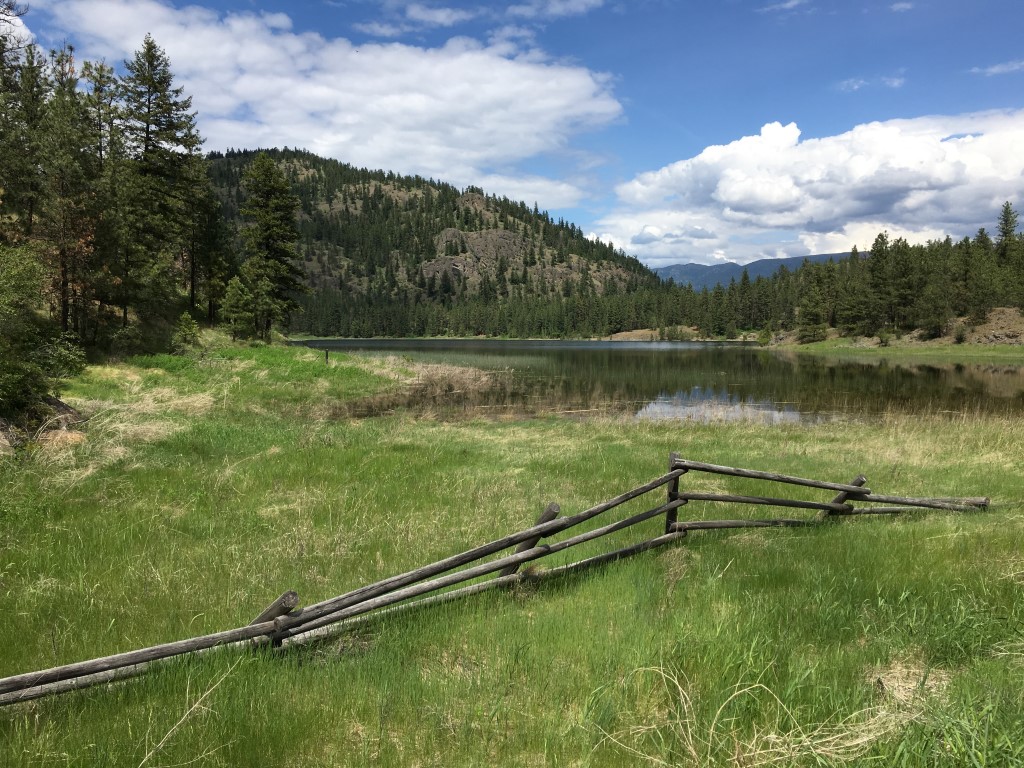
Around the corner we cycled into the big sagebrush bowl at White Lake, quickly adding Brewer’s Sparrow, Lark Sparrow, Clay-colored Sparrow and Mountain Bluebird. A Sage Thrasher sang from the flats, a species we usually miss. Ring-necked Ducks, Green-winged Teal, and a small flock of Wilson’s Phalaropes were on the lake. A single Eared Grebe was a real bonus.
After an hour at White Lake, we sailed down the big hill to Willowbrook and stopped to make a decision about our route from there. It was clear we’d seen pretty much everything we normally pick up along the Secrest route to the south, so we broke with tradition and turned northeast to Mahoney Lake and Green Lake, hoping for the Barrow’s Goldeneye we usually get on the White Lake Road.
Unfortunately, no goldeneye were on either of the lakes, but Eva and Liron heard Chukar from the cliffs on one section where I was uncharacteristically far ahead of the pack. At Green Lake we began the exciting descent down “The Wall” to the marshes north of Vaseux Lake. We cycled north along the river, then crossed over to the highway to go south to Vaseux Lake. A Common Merganser flew by over the lake, White-throated Swifts chattered overhead and a Canyon Wren sang from the cliffs. We decided not to make the climb to the Lewis’s Woodpecker snags, thinking that it was just as likely to get them on the way to Kaleden.

On the boardwalk through the marshes we added Marsh Wren, Cedar Waxwing and Downy Woodpecker. It was 4 p.m. and we had 130 species, close to our record total for a fully green bicycle big day. We turned north for home with only a few gaps on the possible list. We didn’t find any Merlins in Okanagan Falls, but Skaha Lake pulled through with three Common Loons in the first few kilometres. A Belted Kingfisher perched over the shoreline, something we missed last year. Then one of the big highlights of the day—Liron spotted a flock of seven American White Pelicans flying up the valley. As we watched them sailing north a Swainson’s Thrush began giving its “bic” call from the shrubbery, another new arrival from South America. 134 species and a new record for us.
We continued north along the KVR rail trail to Penticton, checking the airport oxbow again and then the Okanagan lakeshore at the SS Sicamous. Nothing new. We turned back up the West Bench Hill and were home by 8:30 with 103 kilometres on the odometer for the day. Eva added a Great Horned Owl for a team total of 135 species—good enough to win the Okanagan Big Day Challenge and bring home the coveted Flammulated Owl trophy at the brunch on Monday morning. Unfortunately I missed the good food and great tall tales of the brunch as I had to catch the 6 a.m. flight back to Ottawa, but I had thoroughly enjoyed another great day of birding and camaraderie!
We did all this to raise funds for the Vaseux Lake Bird Observatory through the Great Canadian Birdathon. If you’d like to donate to the cause, you can click this link. Thank you!
Bicycle Birdathon 2016: an owly surprise
[The birdathon is a fund-raiser for the Vaseux Lake Bird Observatory. VLBO has been conducting bird surveys to monitor long-term population changes in bird numbers for the past 20 years but needs your support to keep going. Please make a donation or pledge at my birdathon website. Thank you!]
Weather is always at the top of the list of concerns at the start of a birdathon, and this year the news was good—the forecast for rain had yielded to a dry, calm, and relatively warm morning. Peter Maser met me at my house at 2:50, so by 3 a.m. we were off into the blackness to meet Eva Durance at the start of the Max Lake Road. We didn’t hear any birds on the 10-minute cycle, but Eva reported a Killdeer had called a few minutes before, so we had one species to start the day.
We had only gone a couple of hundred yards when the first Common Poorwill began calling, then a Sora and Virginia Rail called from a roadside marsh. Violet-green Swallows chattered overhead and a Western Tanager called from the hillside. Poorwills were scattered along the road—we saw eight!—and a kilometre on a Flammulated Owl hooted from high on the mountain. Things were going as planned for once. We checked the nest-boxes for owls but no luck—it’s still a couple of weeks early for Flammulateds to be nesting, but we were hoping the early spring might have moved things along.
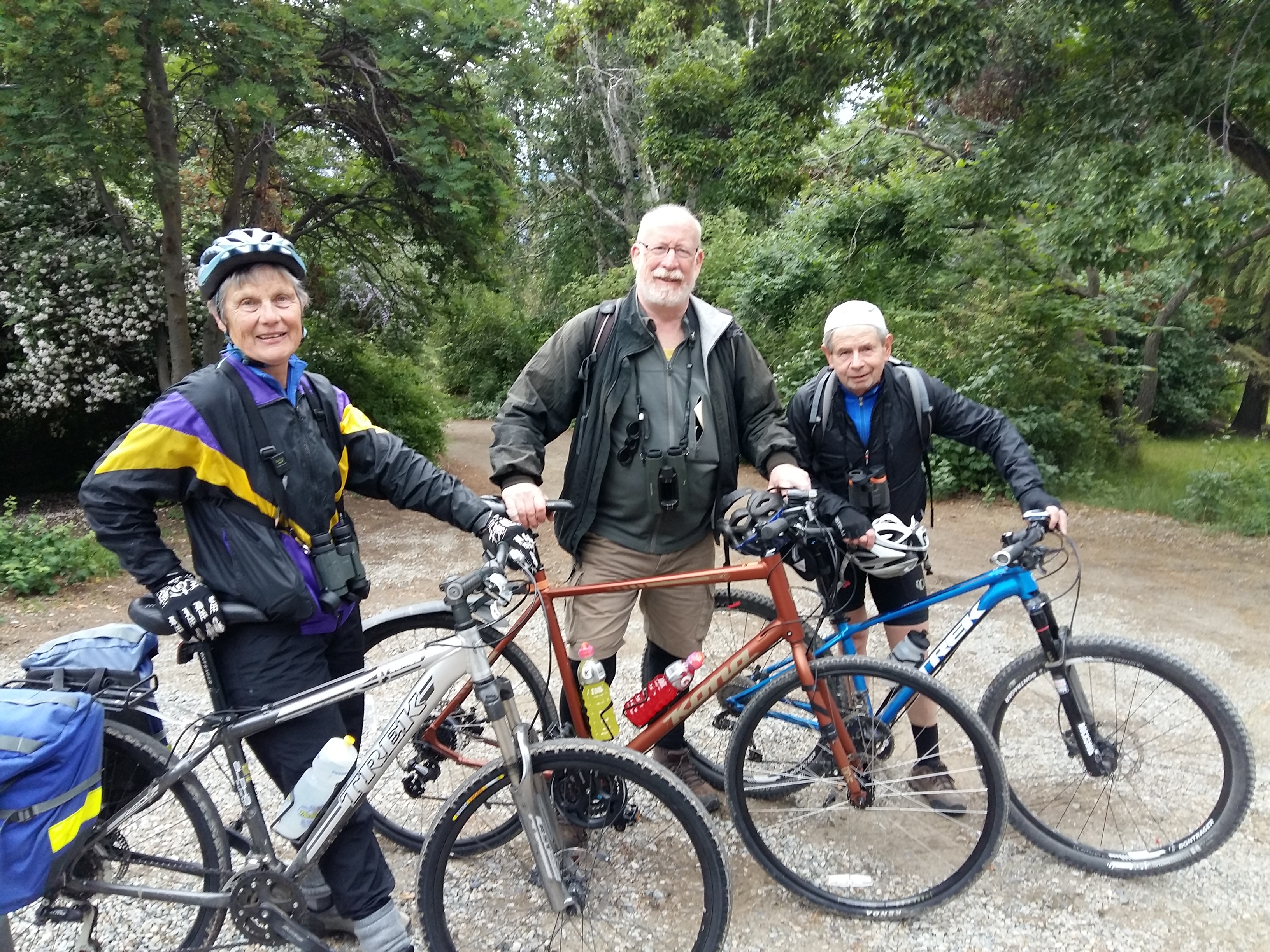
Eva Durance, me and Peter Maser. 6 a.m. and we already had 55 species!
By now it was 4 a.m., so we sat on a log to wait for dawn to break. Robins, Chipping Sparrows, and Spotted Towhees added their voices to the chorus. At 4:30 we got on the bikes and began to slowly work our way down the road. Nashville Warblers and Black-headed Grosbeaks soon dominated the soundscape, but then a strange call up on the slopes of Mount Nkwala caught my ear: chukka, chukka, chukka… The first of several surprises for the day—the first time I’ve ever had Chukar at Max Lake!
Another mild surprise was a couple of Veeries (a bit early) and MacGillivray’s Warblers, and a late migrant Lincoln’s Sparrow was a real bonus. Once back on the West Bench we added garden birds such as Bullock’s Oriole, Brewer’s Blackbird and Eurasian Collared-Dove, and by the time we got back to my house at 6 a.m. our species total was 55—right on target. We celebrated with some fresh coffee and a bit of breakfast, then saddled up and sailed down the hill to the KVR trail to Penticton.
The buzz of a Clay-colored Sparrow on the grasslands below the house was rather unexpected, as were two late migrant White-crowned Sparrows. We were happy to hear a Yellow-breasted Chat singing on cue from the roses below and even more surprised to hear 4 more in the next few hundred yards. We cycled north to Okanagan Lake, where 2 Common Loons, 2 Western Grebes and a Belted Kingfisher were good additions, but again a migrant sparrow stole the show—a singing Savannah at the end of the S.S. Sicamous jetty.
At 7:30 we turned south to cycle the dyke trail to Skaha Lake. The chebec, chebec, of a Least Flycatcher came from the cottonwood grove—another uncommon bird for the list. The muddy oxbow by the Penticton airport had Gadwall, Northern Shoveler, and Blue-winged Teal but nothing to match last year’s Willet for excitement. Pygmy Nuthatches and Vaux’s Swifts at the south end of the dyke gave us 83 species by 8 a.m.
We turned onto the highway and began the serious slog up the Kaleden hill, rewarded by a pair of Golden Eagles at the junction. Turning on to the White Lake Road, we climbed the steep hill to Three Gates Farm and turned in to see what Doreen Olson’s garden would provide. And what a great stop it was! Perched on a log rafter above her front door was a glorious little male Western Screech-Owl. I asked Doreen if she had checked the nest-box on the driveway, but she said that there had been no visible activity there. Peter got the ladder from her shed and I climbed up to look inside—and there was a fluffed-up female owl, bill-snapping in indignation. Doreen provided coffee and juice to help celebrate the find. It was 9:30, we had 92 species and an odometer reading of 32 kilometres.
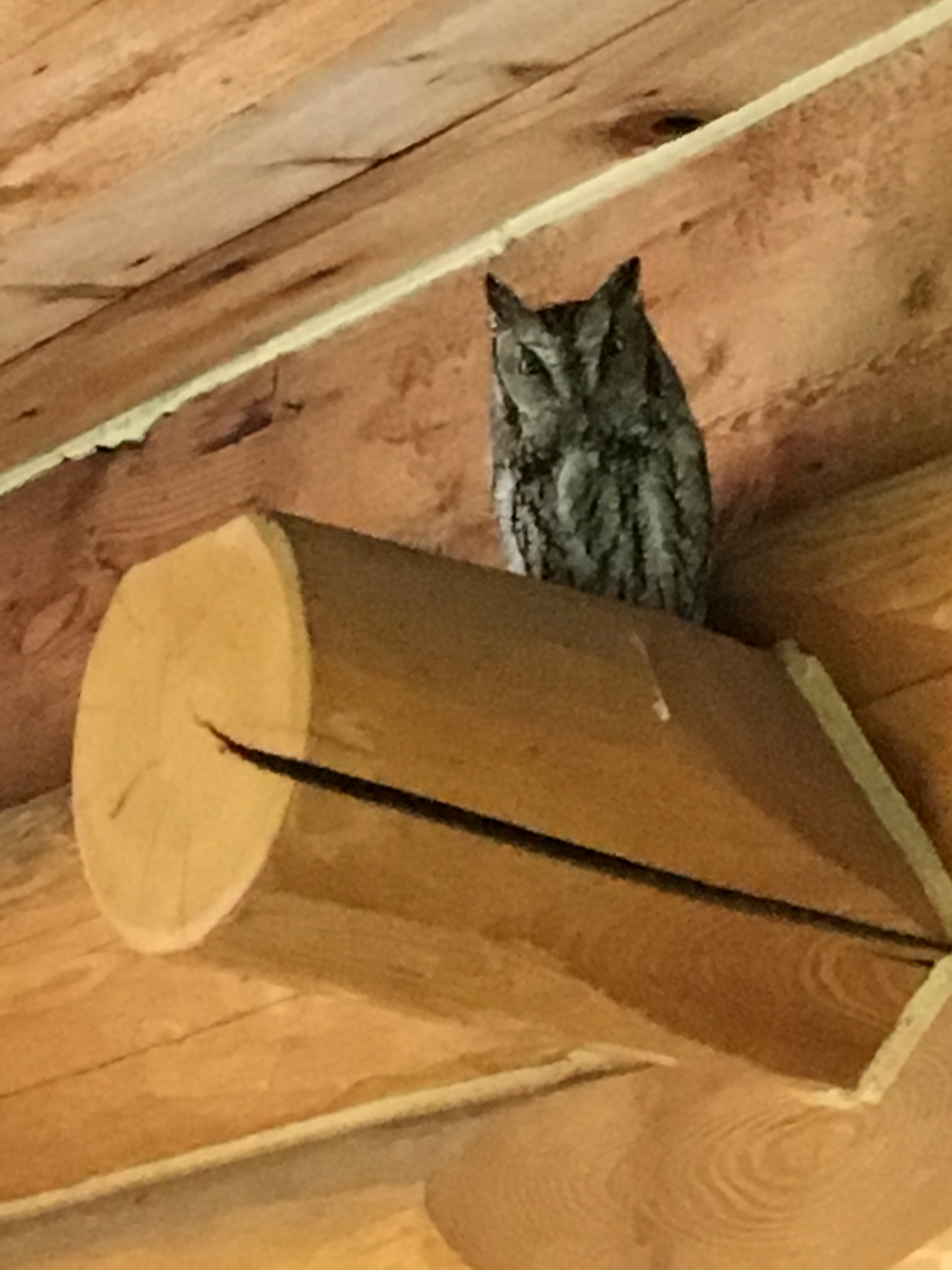
Male Western Screech-Owl
Then it was back on the road and up one of the steepest pitches of the route, a 14 percent grade through the ponderosa pines. At the top we turned off on a side road to check a pond and added Green-winged Teal and Barrow’s Goldeneye. The next pond had the displaying snipe that had been there the day before, but the pair of Ruddy Duck had disappeared. Luckily a Pied-billed Grebe put in an appearance to make up for the miss.
The big sagebrush bowl of the White Lake basin is always a highlight of a south Okanagan birdathon, and this year was one of the best. The beautiful warbles of a Lark Sparrow song greeted us as we turned up the road west of the radio telescope, then the sky-blue flash of a male Mountain Bluebird. At the top of the hill we added the expected Brewer’s Sparrows, and were relieved to hear the long, beautiful song of a Sage Thrasher. Thrashers usually don’t arrive until June at the north end of their range (and this is about as far north as they usually go in the world), so we were very happy to check that one off the list (I had found this bird the day before while leading a day tour for the Meadowlark Festival). And on the other side of the road a Grasshopper Sparrow sang, also discovered the day before—this bird was using the relatively lush bluebunch wheatgrass habitat created by a grassland fire a couple of years before.
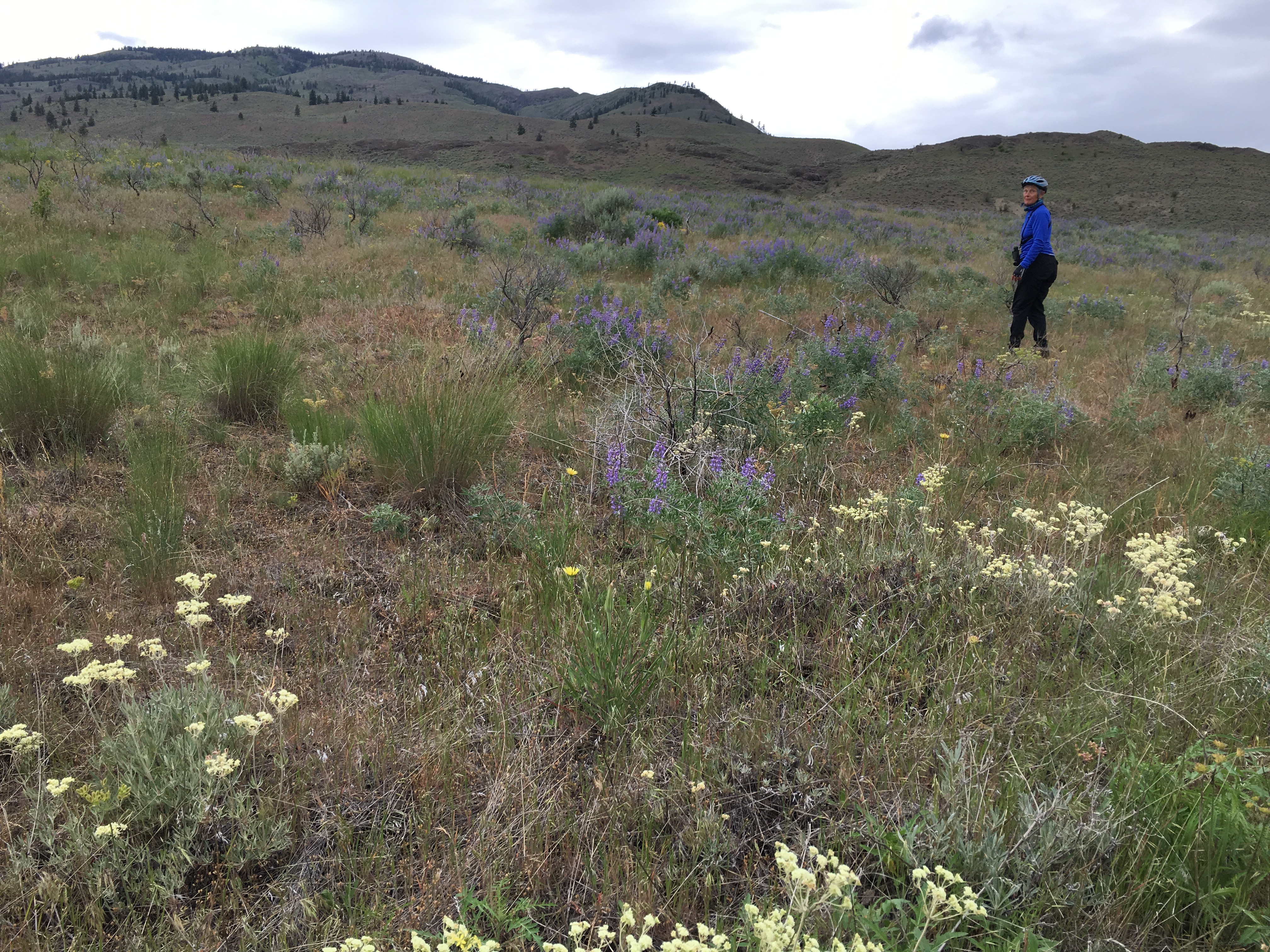
Eva looking and listening for Grasshopper Sparrows in the White Lake basin.
We coasted down the hill toward White Lake itself, then stopped to scope the lake. A flock of wigeon was a nice sight at the north end of the lake, but even nicer were Red-necked Phalaropes in colourful breeding plumage scattered around the shore. And two more Sage Thrashers singing nearby! We waved to the Chafing for Chickadees cycle team across the lake, then pedalled on south. We stopped in a patch of forest to look for a Pileated Woodpecker, but no luck. Meyer’s Flat had White-throated Swifts rocketing overhead and a couple more buzzing Clay-colored Sparrows, and the Secrest scout camp pines had a flock of Red Crossbills. The missing species were slowly getting checked off!
Racing down the winding Secrest Hill we just about collided with another birdathon group coming up—a gang of young birders full of stories and enthusiasm. As we chatted a Lewis’s Woodpecker flapped by. Then one of the biggest surprises of the day—a lone Sandhill Crane soaring overhead. Cranes migrate through in early April, so this one was a month late on the move north. We stopped in at Inkaneep Park, where Eva and Peter heard a Bewick’s Wren while I was using the facilities.

Then it was north and homeward. We were two hours ahead of last year’s rain-delayed schedule so feeling confident about the return trip. We made a swing through the Gallagher Lake trailer park in a vain, desperate attempt for Clark’s Nutcracker (we should have had them while eating breakfast at my house!). A pause on the busy highway below the massive rock face of McIntyre Bluff gave us a singing Rock Wren, but no Peregrine showed.
As we got to Vaseux Lake I was relieved to hear the nasal calls of begging juvenile Clark’s Nutcrackers, and there was a family of them in the pines by the cliffs. We made a quick stop at the big cliffs at the north end, whistling for Canyon Wren. I didn’t hear a reply, but saw a movement on the rocks high above and there he was, flashing his rusty tail.
We cycled through the poison ivy to the boardwalk, meeting up with part of the young birders team once again. Singing Marsh Wrens and Common Yellowthroats were a couple more easy additions, as were the Redheads and Red-necked Grebe on the lake and the Ring-billed and California Gulls at the river mouth.
A stop at the Vaseux Lake Bird Observatory site north of the lake might give us Cinnamon Teal, Northern Harrier and Yellow-headed Blackbird, so we ducked down the trail to the oxbow and ditched our bikes. We were immediately beset by a Yukonian swarm of mosquitoes so just ran through the willows and marsh grass out to the dyke, swatting as we went. No teal, no harrier, but fortunately we saw two or three distant Yellow-headed Blackbirds flying over the distant cattails, flashing their white wing patches.
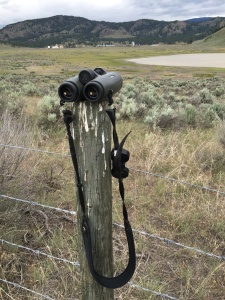
Looks like there must be birds out there!
At Okanagan Falls we decided to take the rail trail along the west side of the lake. We were running out of options for easy additions to the list, but a single male Lesser Scaup hugging the shore gave us one more. It began to rain lightly, then heavier as we pedalled north, watching for any dots on the lake that might be a Horned Grebe or anything new. But the only dots we saw were Common Loons and Western Grebes.
We were drenched by the time we got back to Penticton, meeting up with Glenda Ross at the airport oxbow. Unfortunately, no Cinnamon Teal had miraculously appeared over the course of the day, so we slogged on to Okanagan Lake again. The north end of the Okanagan River was a spectacle of swallows in the rain—thousands and thousands of all six species (Tree, Violet-green, Northern Rough-winged, Bank, Barn, Cliff) flew over the water and perched on sagging wires. We scanned the lake for grebes and the beach for gulls but couldn’t pull one last new species out of the bag. At 7 p.m. we turned for home, unaware that we were cycling by a lovely male Harlequin Duck at the dam seen moments before by the Chafing for Chickadees gang.
Wet but happy to be off the saddle after a long eventful day, we said our goodbyes and made the final checklist tally: 126 species, 102 kilometres and 900 metres vertical climb (Peter’s GPS kept track!). A very respectable total, but regrettably second in the team competition to the 131 species seen by the Chafing for Chickadees team. Next year!
The birdathon is a fund-raiser for the Vaseux Lake Bird Observatory. VLBO has been conducting bird surveys to monitor long-term population changes in bird numbers for the past 20 years but needs your support to keep going. Please make a donation or pledge at my birdathon website. Thank you!
Bicycle Birdathon 2015: a wet, willety day
It was the sound you don’t want to hear at 2 a.m. when you’re waiting for your alarm to go off in readiness for a birdathon. Especially a bicycle birdathon. The sound of steady rain, occasionally interspersed with the sound of heavy rain. I was supposed to meet Eva Durance at 3:15 to start our birdathon, so at 2:45 I phoned her and suggested that we start at 4. I checked email, chatted with the team of young birders staying at our house who were doing their birdathon by car before they left at 3 and got my gear together. At 3:30 I called Eva again to say 4:30 for sure—owling was pointless, but by then the dawn chorus would have started and we didn’t want to miss that.
So I cycled off at 4:15 in full rain gear, something I don’t usually do in the Okanagan, where if it’s raining you usually wait a half-hour until the rain stops. I pumped up the hill towards Max Lake, surprised to hear a bickering Western Tanager complaining about the weather in the darkness. Eva was waiting for me at the start of the gravel road. We compared notes and found we had four species despite the downpour, then added two more as some Violet-green Swallows chattered somewhere overhead in the blackness and a Spotted Sandpiper called from the park lawn next to the road, perhaps mistaking its flooded state for a permanent pond.
We rode up the track to Max Lake, dodging enormous puddles as best we could. Amazingly, a Common Poorwill called from the hills to the west, something that doesn’t usually happen in weather like this. Dawn came very slowly, but out of the murky gray we heard Soras and Red-winged Blackbirds call from the marsh, a migrating Hammond’s Flycatcher peeped from the willows and a few die-hard Black-headed Grosbeaks, Western Tanagers, Nashville Warblers and Townsend’s Solitaires sang from the pine woodlands. The dawn chorus was a shadow of its normal self though, and was surprisingly dominated by Spotted Towhees, a species which seemed to care less about the steady rain.
At 5 a.m. we turned around at the end of the road, checked a couple of nest-boxes for possible owls (no such luck), then coasted back down through the sand, gravel and potholes. By the time we reached the houses of the West Bench again we only had 22 species, adding 8 more to reach 30 by the time we got back to my house. Normally we have 55 species at that point, and normally we’re dry enough to guzzle down some coffee, repack for the day and take off by 6:30 to really hit the road. This wasn’t a normal day, obviously, so we shed most of our clothes and put them in the dryer while we watched the feeders for hummingbirds (Rufous, Calliope, but no Black-chinned) and the nest-box for Red-breasted Nuthatches feeding their young (check!).
By 7:30 our clothes were dry, so I switched out my hiking shoes for muck boots and we were off into the deluge again. There was no sense that the rain would stop—we couldn’t even see the other side of the valley for the clouds. But the Lazuli Buntings were singing when we hit the KVR trail below the West Bench and a Yellow-breasted Chat sang from the roses. A field-guide-page of swallows lined the wires over the Okanagan River, so we didn’t have to worry about that family for the rest of the day. A pair of Wood Ducks flew by, a nice bonus as well. Things were looking up despite the short species list.
At Okanagan Lake we had a pair of Red-necked Grebes, then a pair of Horned Grebes. Three adult California Gulls on the beach confused me for a few seconds, as they were so intensely coloured that they lacked the black spots on their bills. I fought back the urge to call them pale Lesser Black-backed Gulls (they had dark eyes after all)—we were happy to see any gulls at all! By 08:50 we were heading south along the river again, about an hour behind schedule but determined to enjoy this day whatever it brought. A Belted Kingfisher boosted our morale, since we’d almost missed that species last year.
One of the best spots for bird diversity along our route is the muddy river oxbow on the east side of the Penticton Airport. It hadn’t held much of interest a few days ago, but I was happy to see a Lesser Scaup and a pair of Northern Shovelers right away. As I scanned the north shore, Eva said, “What’s that big shorebird?” I looked over to the south, and there was a lovely Willet! This would surely be bird of the day—I’d only seen one of these handsome birds before in the Okanagan, and there were only three previous records for the valley. All negative thoughts about the rain (still coming down!) vanished.
When we got to Skaha Lake we scanned the waters (thankfully very calm) and came up with three late Bonaparte’s Gulls, a small flock of Western Grebes and a Common Loon. Then it was up the long, long hill to Kaleden, the big trucks roaring by in clouds of spray on this least favourite part of our route. We were more than ready to leave the highway behind when we turned off onto the White Lake Road at 11 a.m., and within a few minutes were sheltering in the porch of Doreen Olson’s home. Doreen wasn’t home, so we couldn’t beg for coffee, but my wife Margaret dropped by with fairly dry shoes so that I could take off my big boots once the rain stopped. A male Black-chinned Hummingbird came repeatedly to the feeders there, but we couldn’t find the Great Horned Owl we’d seen there yesterday.
A series of woodpeckers made the continued hill climb easier to take—a pair of Hairies, then a calling Pileated (which I missed) and a Red-naped Sapsucker that flushed out of the ditch of all places. A Lewis’s Woodpecker at a traditional nest site allowed me to catch up on a species Eva had seen in Kaleden. Then the glorious flatness at the top of the hill. We took a short side trip to a small pond to find a female Barrow’s Goldeneye with a brood of tiny ducklings, then a pair of Cinnamon Teal. At Prather Lake a Marsh Wren sang from a ridiculously small patch of reeds. We pulled over at the big pond south of St. Andrews to add some species I’d tied down their yesterday. A pair of Pied-billed Grebes put on a show with 7 little grebelings, a pair of Ruddy Ducks eventually appeared, and a couple of Wilson’s Snipes called. Then my brother Syd stopped by on his way to White Lake, and thankfully was carrying a couple of coffees to warm us up. The combination of coffee, a definite let-up in the intensity of the rain, and the fact we had 96 species—within spitting distance of respectability despite still being an hour behind schedule—greatly boosted our spirits.
The luck continued with a Rock Wren singing from a bluff just down the road—I’d never heard one there before, then Eva spotted a Downy Woodpecker. I cycled back to find it but never did—but as I pulled over to look a Ruffed Grouse drummed from the shrubby tangles in the roadside aspens. At White Lake we quickly added both Western and Mountain Bluebirds and a Lark Sparrow. We listened for Sage Thrashers at the top of the hill north of the lake, but heard only Brewer’s Sparrows—nice to get but not the Holy Grail.
Near the lake we came across another cycling birdathon team: Kirk Safford, Tanya Luszcz, Ruth Joy and James McKinnon. They were having lunch, drying off (the rain had stopped!), and scanning the lake with a big spotting scope. We hadn’t packed a scope because of the weather, and I could see a single phalarope spinning around in the lake, too far for binocular identification. We could hike down to the lake to get close enough, or we could save time (and wet feet) by bribing them to use their scope. We decided to tell them about the Willet (something not normally done in the heat of a big day competition) to access the scope, which immediately gave us a Red-necked Phalarope for the list. Good deal! We said thanks and goodbye and continued up the hill south of the lake, but before we had got more than a hundred metres I heard the distinct sound of a singing Sage Thrasher. I looked back to see if anyone in the other group was holding up a smartphone, but it appeared they were looking in the direction of the thrasher song, so we happily added that to the list as well.
We decided to forego the usual hike around White Lake (for Grasshopper Sparrow and Gray Partridge) because of our schedule problems, nor did we take the 1-hour side trip in to Mahoney Lake. We sailed down the hill to Willowbrook and on to Myer’s Flat, where a coursing male Northern Harrier was a nice surprise, as was a singing Gray Catbird—the first of the year. We were still missing White-breasted Nuthatch, so stopped in at Kurt and Marianne Hutterli’s place to see if their birds were still nesting in their house (their own house—not a bird house!). And after a few minutes—bingo!—there it was at the gap in the boards below the roof. Five Turkey Vultures over Covert Farms brought our total to 111 by 3 p.m., then a Sharp-shinned Hawk flew by. Hack’s Pond was devoid of ducks, but a single (!) Solitary Sandpiper was a real bonus. We stopped at River Road to call for Bewick’s Wren, but eventually gave up, only to have one call at us derisively as we saddled up to leave.
It was 4 p.m. and time to turn north again for home. We still had some serious misses hanging over us, so we pulled into the trailer park in the pines at Gallagher Lake, quickly adding Eurasian Collared-Dove (phew) and then a Canyon Wren singing from the massive cliff. Our real goal there was Steller’s Jay, so were relieved as one called just as we left. No Vaux’s Swifts, though.
At Vaseux Lake we found some Redhead, and after a lot of scanning and a few false starts we spotted a nice Golden Eagle over the cliffs. The boardwalk didn’t produce anything new, and neither did the banding station area. We were still missing Yellow-headed Blackbird, but despite a lot of looking and listening above the big marsh we couldn’t find any. At Okanagan Falls we got onto the KVR trail on the west side of Skaha Lake and cycled through Kaleden, finding a single White-crowned Sparrow near Sickle Point, but no Yellow-headed Blackbirds there, either. At 8 p.m. we came full circle back to the muddy oxbow at the airport. A male Blue-winged Teal had arrived, and two Wilson’s Phalaropes spun with the shovelers. The Willet was still there, and has we saddled up to go, there was Kirk and his team coming down the trail from the north to cash in on that information!
We checked out the Okanagan Lake shoreline again as darkness settled, then pumped up the big West Bench hill to get home by 9 p.m. We’d gone 106 kilometres and tallied 122 species—not bad for such an inauspicious start. At the brunch the following morning we found out that our total was good enough for first place in the “green” birdathon category; Kirk’s team was only one behind at 121. Remember, this was all done to raise money for bird conservation, so if you’d like to donate something to the cause (the Vaseux Lake Bird Observatory) please click here. Thank you! And if you want more information about the event, it’s part of the Okanagan Big Day Challenge and the Meadowlark Nature Festival. See you next year!
Bicycle Birdathon 2014
The day began with a huge sigh of relief. The weather forecast for the past few days had shown a solid day of rain for Sunday—the Sunday of the Victoria Day weekend, the traditional day for the Okanagan Big Day Challenge. And it’s one thing to do a Birdathon in the rain, but to do a bicycle Birdathon in the rain all day is something I’d rather not contemplate. Hence the relief when I stepped outside at 2:15 a.m. and saw starry skies and felt not a breath of wind. John Reynolds and George Clulow arrived at about 2:45 and we were off on our bikes in the darkness. We met our fourth team member, Eva Durance, at the start of the Max Lake Road at 3:15, just as a Common Poorwill called from the ponderosa pines ahead of us. Species number one—we’d need a few more to reach our goal of 130! Eva said it was species number two for her—she’d heard a Great Horned Owl calling as she left her house.
We clattered through the potholes to Max Lake, where a Sora called, then a Virginia Rail—things were going as planned. A couple of kilometres later we passed a parked car and a couple of small tents right where we usually try for Flammulated Owls, so I quietly led the group a few hundred metres on so as not to disturb their sleep. After a few imitated hoots, a Flam called in the distance, then another. We climbed the steep hill to check the nest-boxes, but no owls looked out—too early in the season, I imagine. It was 4 a.m., still dark, so we had nothing to do but lie back in the pinegrass and wait for the dawn and its chorus of songbirds. A few seconds later a robin called and the frantic early morning listing began.
We slowly worked our way back down to Max Lake itself, the pines and firs ringing with Townsend’s Solitaire, Western Tanager and Black-headed Grosbeak song. The temperature had dropped a few degrees, and we kept adding layers and gloves but still got good and chilled. By 5:20 we had 30 species, enough to feel good heading down the big hill to my house. A Great Blue Heron flying high overhead was a surprise—and a relief, since their small colony in Penticton had shifted and was hard to see from our route. A Eurasian Collared-Dove flew up from the roadside—this species had finally colonized my neighbourhood after several years of taking over surrounding towns. At home we refuelled with hot coffee and repacked our bags for the long ride to the south. Eva spotted a Black-chinned Hummingbird at the feeder, but a Rufous chased it off before the rest of us could get a look. Hopefully we’d be able to make that one up along the way.
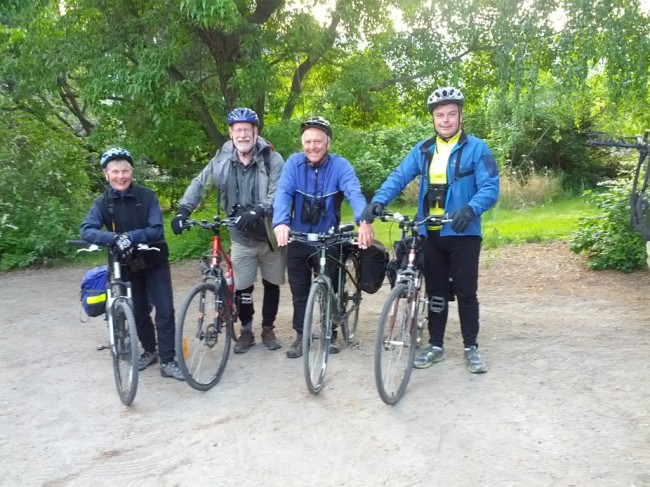
Looking a little brighter at 6:30 a.m.! Eva, myself, George and John set out from my home to continue the adventure.
At 6:30 we were off again, down the KVR trail to the Okanagan River. Several Lazuli Buntings sang from the bushes, and a single Yellow-breasted Chat—just arrived from Mexico last night—sang from the rose thickets below. Along the river we picked up most of the swallows, but the Bank Swallows weren’t at their usual bank—I only had a couple of sure spots for this species so hoped this wouldn’t be a bad miss. We looked out over Okanagan Lake, where a single Western Grebe and 3 Bufflehead were nice additions, as was a young Ring-billed Gull on the beach. Gulls are hard to find in May in these parts!
This was one of the earlier dates we can do a Birdathon, and several species hadn’t been reported yet as back from their wintering grounds. We listened hard for Willow Flycatchers, Gray Catbirds, Eastern Kingbirds and Veeries along the cottonwood groves by the river, but no luck. The muddy oxbow east of the Penticton airport had pairs of Northern Shovelers, Gadwalls and Yellow-headed Blackbirds, but most of the other ducks had flown north in the past week, and there were no interesting shorebirds at all. A quick stop at the Skaha Lake beach produced a single Common Loon and a dozen more Western Grebes.
It was time for the first big physical effort of the day—the 7-km climb along Hwy. 97 to Kaleden. In the past, we’ve gone down the east side of Skaha, which is less hilly, but for a change this year I decided to reverse the day—putting the big climb in the morning and leaving the level biking for the afternoon and evening. We’d also avoid the traffic congestion of the Peach City Half Marathon along that east side route. The others quickly pulled away on the big hill as my lack of conditioning became apparent. I listened for Lark Sparrows along the way, but the only new species I saw along that stretch was a raven. I caught up to the gang in Kaleden, where a Lewis’s Woodpecker soared out from a hilltop snag.
At 9:15 we turned off on the White Lake Road, quickly adding Western Wood-Pewee and Hammond’s Flycatcher before stopping in at Doreen Olson’s home at the top of the first big hill. Doreen was off leading a Meadowlark Festival field trip, but had kindly left a jug of cold water on her porch for us to refill our bottles. An adult Great Horned Owl looked down on us from the big fir where they’ve nested for over a decade, and a male Black-chinned Hummingbird came to the feeder, allowing the rest of us to catch up to Eva in one fell swoop. We hung around Doreen’s for 25 minutes or so, hoping to get the White-breasted Nuthatch that was there yesterday, but eventually gave up and tackled the next big hill on the route.
After adding American Kestrel and Say’s Phoebe in the first kilometre, a small black car pulled up—it was Catherine Jardine and friends, out doing some serious Okanagan target birding. Catherine pointed out that it was their camp along the Max Lake Road; had I known I wouldn’t have felt so bad about hooting for owls outside their tent! I gave them directions to a Black-throated Sparrow discovered the day before at Osoyoos, handed them the map and cycled off while they went back to Doreen’s for the Black-chinned Hummingbird. I caught up to the rest of the gang as they were pointing out a Pine Siskin at a feeder—this usually common species had been basically absent from southern BC for the past six months so we were relieved to get one. I reached for my notebook to write it down and discovered that I hadn’t just given Catherine the map to the sparrow, I’d handed over my notebook with the map in it. Arggh! Luckily, Eva had also been keeping a running tally of our birds.
A quick side trip to a small pond produced a family of Barrow’s Goldeneye ducklings and a Green-winged Teal, a Bald Eagle soared over the next lake and a Wilson’s Snipe called from the marsh. Then on to White Lake, where the grasslands held great promise for new species. A Western Bluebird at a nest box, Brewer’s Sparrows singing from the sagebrush, Savannah Sparrows still migrating through the basin. Catherine and gang drove by again and dutifully handed back my notebook. We stashed our bikes and hiked up the hills to the south of the lake in a traditional march to find Gray Partridge and Grasshopper Sparrow. These marches have usually been fruitless, but they provide some relief from the bicycle saddle and I simply love walking the grasslands in spring. It was hard to listen through the din of meadowlark and Vesper Sparrow song, but near the top of the rise I caught the insect-like trill of a Grasshopper Sparrow (species 100!), and soon we all had good looks as he sang from atop a sagebrush. No partridges, but we were happy with the results of the walk. After a long hard look we found four Wilson’s Phalaropes on the lakeshore as White-throated Swifts chattered overhead. It was noon.
We sailed down the big Park Rill hill south of White Lake, slamming on the brakes to see a lovely adult Golden Eagle over the cliffs to the west. We stopped at a nearby nest box that had had a Western Screech-Owl looking out of it yesterday—no sign of the owl, and a broken egg below the box didn’t bode well. I boosted Eva up on my shoulders to look into the box, but it was empty. I trilled my best screech-owl trill, but only managed to call up an astonishing variety of forest birds—no owl (and no White-breasted Nuthatch—yikes). We stopped at the Secrest Scout Camp to look for nuthatches, but by now it was 2 p.m., sunny, hot and windy. The forests were quiet as we checked a number of bluebird boxes, hoping to find one being used by the local White-breasted Nuthatches. We bumped into Michelle Hamilton and Grant Halm, members of our team in previous years, but they had no nuthatch information to pass on.
As we got to the big flats at Covert Farms, I saw Marianne Hutterli through the pines, planting in her vegetable garden. I mentioned to John that Marianne was a local birder, and he immediately said “We should ask her about White-breasted Nuthathes!” So we turned off the road, then up her driveway. To our surprise, she replied to our blurted question “Oh yes, we have a nuthatch nest in our house.” And there, under the eaves, was a little gap in the boards through which a pair of White-breasted Nuthatches were shuttling to feed their young. After some more water refills, we thanked the Hutterlis and were off to River Road, sailing down the extraordinary Secrest Hill, which I can attest is a big challenge to cycle up! At the bottom of the hill we ran into the convoy of the Western Teenagers, a group of young birders that were doing a car-powered Big Day in the area. We tore away from their excited stories to check off Bank Swallow around the next corner (phew!), and there unexpectedly met more birding friends, including Dan Kemble, the compiler of the Carcross, YT Christmas Bird Count, someone whom I’ve talked with many times on the phone but never met. Such is May birding in the Okanagan!
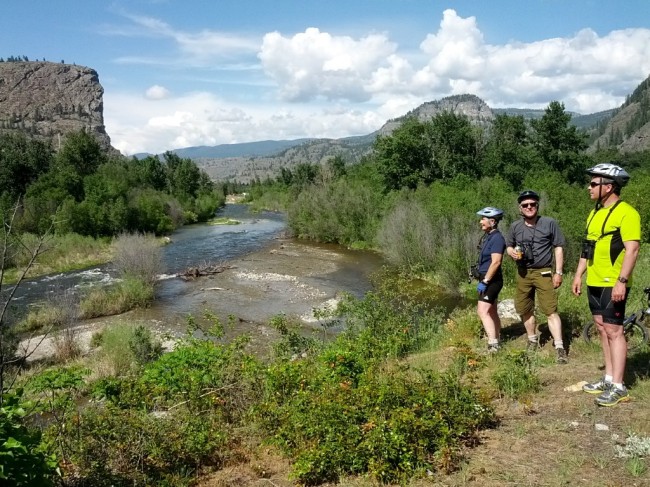
Looking for Vaux’s Swifts (or Hooded Mergansers, or Merlins, or anything new!) along the Okanagan River south of McIntyre Bluff
A male Cinnamon Teal was a bonus at Hack’s Pond, but we couldn’t find a Bewick’s Wren along River Road. A Vaux’s Swift twinkled overhead as we got back on the highway and headed north to Vaseux Lake. We were well down in our species total so were hoping Vaseux would come through in a big way to get us back into respectability. At the south end of the lake a few Redheads and a single Lesser Scaup were joined by a pair of Blue-winged Teal flying in. Then John spotted a pair of Red-necked Grebes dancing along the marshy shoreline. Things were looking up. At 4:00 pm we cycled up the McIntyre Creek road to the big cliffs—a kilometre of hill I wasn’t planning on—but were rewarded with Rock and Canyon Wrens singing. No Chukar cackled, though. A run out on the boardwalk produced Pied-billed Grebe, Cedar Waxwing, Marsh Wren and some distant Ring-necked Ducks. We stopped in at the Vaseux Lake Bird Observatory site and hiked over to the river channel, where we spotted a pair of Northern Harriers, but no kingfisher. It was 6 p.m. when we left, and our total was 118.
I really wanted to get to 120, but what could we add? A stop in Okanagan Falls failed to produce Merlin, and the dippers hadn’t been at the dam for a couple of years. We cycled along the west side of Skaha Lake along the old KVR trail, praising its condition on the southern end and cursing its deep sand, silt and gravel on the northern half. Finally, just as we reached the north end of the lake, a Belted Kingfisher called to us as it perched over the shore on a shrub. 119. No Lark Sparrow, though. We were hoping from some new shorebirds at the airport oxbow, but only saw the usual gang of ducks and killdeer. As we went by the cottonwoods farther north I slowed down, hoping to hear the nasal call of a Veery. Instead I heard a soft “whit!” that sounded a lot like a Willow Flycatcher. We stopped and spent a long time trying to get a good look at the bird, but it stayed frustratingly low in the shrubs. I finally got a short but good view of a brownish flycatcher, orange lower mandible, enough for me to call it a Willow. The 120th species. We finished the day at the south end of Okanagan Lake, 9 p.m. nothing new. One last hill up to home and we were done, in more ways than one. With 104 kilometres behind us, we had the pleasure of collapsing into bed and storing another year’s worth of memories in our Okanagan Big Day Challenge memory banks! Remember–this is all in aid of bird conservation and the Vaseux Lake Bird Observatory–if you’d like to make a Birdathon pledge to our team, click here. Thanks!
Bicycle Birdathon 2013
I was a bit apprehensive about the Baillie Birdathon this year. I’ve been doing it as part of the Okanagan Big Day Challenge for quite a few years (and have been doing the OKBDC for 28 years now!), and for the past 10 or so years we’ve done the Challenge as a green event—the birding is by bicycle or by foot. Last year I’d been fairly fit in advance of the event, but I got involved in politics last summer, and the spring election campaign had severely limited my biking time. My campaign manager had let me arrive late to the office on one or two mornings a week, but the longest distance I’d biked for the past 6 months was about 15 km. After the election last Tuesday (I was unfortunately unsuccessful), I looked forward to the Birdathon, but the lack of time in the saddle was worrying.
We were five again this year—Eva Durance and Sebastian Pardo from last year’s team, joined by John Reynolds and Christopher di Corrado. The weather forecast was decent—relatively cool with no rain—but a north wind predicted for the afternoon might make the return trip a little more challenging. The alarm went off at 2:30 a.m. on Sunday May 19th, and we were out the door just after 3. The route begins with a good climb to ward off the early morning chill (7⁰C), and by 3:20 we were at Max Lake, a marsh nestled in a narrow valley northwest of Penticton. The first surprise was having a taxi bounce by us on the rough road, fuelling speculation as to what it was doing there in the pre-dawn darkness (the track dead ends about 2 km past the lake).
But we were brought back to reality by the calls of Soras and Virginia Rails from the marsh—the listing had begun. A Song Sparrow sang from the cattails and a Dusky Flycatcher chirped on the hillside. We pedalled on up the valley, meeting the mysterious taxi coming back down the hill. We stopped at the forks and soon heard one of our target nightbirds—a Common Poorwill. As it slowly got lighter, more poorwills began singing from the open pine forest, then the low hoots of a Flammulated Owl. We tried to call the owl in, as John had never seen one, but only Seb glimpsed it as it flew overhead. At 4 a.m. the dawn chorus began with the usual early risers—American Robins and Townsend’s Solitaires, soon joined by Chipping Sparrows, Spotted Towhees and Nashville Warblers.
We biked to the very end of the road, where it ends in a narrow rocky canyon. As we turned around to begin the trip back, Christopher pointed out the first surprise of the day—a Pacific Wren singing from the bushes—this species is usually at much higher elevations in the breeding season. Bonus! As we coasted down the bumpy gravel track we added more common species and a couple of species that can be difficult in May—a calling Cooper’s Hawk and then a Steller’s Jay imitating a Red-tailed Hawk. A MacGillivray’s Warbler warbled from the willows, a male Calliope Hummingbird performed overhead and a Western Bluebird called softly from the pines.
By 5:30 we were out of the Max Lake valley and back in civilization, adding Say’s Phoebe, American Kestrel and Clark’s Nutcracker on the fly. We got back to my house just before 6 a.m.—on time and, with 56 species in the bag, on target. We were missing one common forest species though, having dipped on Red-breasted Nuthatch at Max Lake. I grabbed the ladder to have a look in our nest box, which had held newly hatched nuthatches two weeks ago, but my heart sank when I found the box empty. Hopefully they had fledged safely, but I knew it might be difficult finding this species farther down the road. And the hummingbird feeders were quiet, too; I’d hoped to get a Black-chinned here.
After a half-hour break to refuel and adjust clothing layers, we were back on the bikes and heading down the hill to Penticton. As we got onto the Kettle Valley Railroad trail I spotted a hummer on top of a Saskatoon bush—male Black-chinned! A little farther on a Ring-necked Pheasant rocketed away down the hill, and a Yellow-breasted Chat called from the big rose thicket. As we pedalled north up the Okanagan River channel dyke, we added Gray Catbird and Veery, two species just arrived from their wintering grounds. Okanagan Lake was disturbingly empty except for a single coot at the dam and four Lesser Scaups flying by. No loons, grebes, or gulls. Sigh.
We turned around and headed downriver again, bumping into my son Russell’s large group of walking birders. After the usual guarded pleasantries typical of Birdathon competitions, we continued on our way. The airport oxbow was largely empty of ducks, perhaps because of the two Bald Eagles perched on its shoreline, but a late Bufflehead was welcome. The north end of Skaha Lake produced Western Grebe and Ruddy Duck, two easy-to-miss species. Another surprise was a Red Crossbill singing in the ponderosa pines of the small city park. The trip down the east side of the lake added Eurasian Collared-Dove (surprisingly still absent from Penticton itself, but locally common everywhere else in the valley).
We reached Okanagan Falls at 9:45 a.m., about an hour behind schedule and slipping back on the species total. An Eastern Kingbird—first of the year—flycatched by the dam, but we couldn’t find any dippers. The Merlins were missing from downtown. As we cycled past TIckleberry’s ice cream parlour I mused that it would be nice to see a Peregrine Falcon, and then noticed a bird above two soaring Red-tailed Hawks—a Peregrine!
The new species came thick and fast when we got to the marshes and birch woodlands of Vaseux Lake. We cycled out to the dyke at the Vaseux Lake Bird Observatory, adding all three species of teal in the flooded pasture. I hadn’t told the others about the real reason to go out to the river, so they were happily surprised to see the Long-eared Owl on its nest! A side trip out on the boardwalk was less productive as the lake seemed to have nothing but Redheads on it. Conscious of our schedule, we stopped only briefly at the big cliffs, but couldn’t whistle up any wrens, nor could we see any Lewis’s Woodpeckers. Fortunately a gorgeous Lewis’s flew by farther south along the lakeshore, and as we stopped to admire it a Rock Wren sang from a nearby bluff. As we passed by the huge wall of McIntyre Bluff a Canyon Wren sang from the boulders at its base. Phew. We cycled through the pines at Gallagher Lake, hoping to find our missing Red-breasted and White-breasted Nuthatches, but only added a Vaux’s Swift that dashed overhead.
At the Okanagan River bridge just before 1 p.m. and paused to consider our options. The normal route would take us north up the formidable Secrest hill and on to White Lake for its sagebrush species. But Road 22 was only 20 easy kilometres to the south and had been a frenzy of rare waterbird activity in the past few days. Although the southern route would be significantly longer, we decided to give it a try, as John said “in the spirit of a true Birdathon, let’s do something crazy”. So we turned south and cycled down the beautiful riverside trail to Oliver. We quickly added three species, giving us the feeling that we’d made the right decision—a Western Wood-Pewee called, a Pileated Woodpecker flew overhead, and Eva spotted a family of Great Horned Owls roosting in a big tree.
At Road 9 we turned east to join the highway to scan Deadman Lake, but were mildly disappointed to add only Common Goldeneye there. We arrived at Road 22 and were happy to see white birds in the flooded field. Dang—only Ring-billed Gulls. No Franklin’s Gulls, avocets or Snow Geese. But two Long-billed Curlews foraged nearby, a Bobolink sang, then the real surprise as three Forster’s Terns flew low overhead! A Greater White-fronted Goose made up for the lack of Snows. We finally found the Red-necked Phalarope amongst the Wilson’s, spotted a Lesser Yellowlegs, and then happily added a flock of Bonaparte’s Gulls that arrived just as we were leaving. We’d added 11 species at that one spot.
We took Black Sage Road north, where Seb somehow picked out a Northern Harrier perched in the marsh grass. A stroll through the antelope-brush filled Christopher’s shoes with cacti, but no Lark Sparrow. John pointed out the flooded field across the river—we scanned it hopefully and found the missing Snow Geese! Just down the road a Lark Sparrow sang from the vineyards—species number 125 for the day, only one behind last year’s total.
We got back onto the river trail, hoping to add something on the long road home. The north wind had appeared as forecast, but we put our heads down and kept going. We paused at Vaseux Lake to look at the Lewis’s Woodpecker again and were surprised to find another family of Great Horned Owls, this time in a burned-out ponderosa pine. Scolding crows in Okanagan Falls were unfortunately after a Cooper’s Hawk, not a Merlin.
We decided to take the west side trail along Skaha Lake simply because it offered a lack of hills. The first part is delightful, the second half scenic but rough and loose for road bikes. A Belted Kingfisher was added after a two-hour drought, but no loons. We checked the airport oxbow again and were happy to see a little group of Northern Shovelers. A final side trip to Okanagan Lake produced nothing new from the bird world, but we did meet up with Kirk Safford’s cycling team (who had started at Max Lake, too, but somehow we’d missed them all day). The West Bench hill provided our last challenge, but we were happy to get home at 9:06 p.m. with 127 species, having cycled 138 km.
I do this Birdathon to raise money for the Vaseux Lake Bird Observatory, which relies on the funds to monitor migrant bird populations in the Okanagan Valley. You can donate to the cause by visiting my Birdathon website and clicking on “Give Now”. Thank you!
Winter birding wonderland
It has been some time since I wrote in this blog, so I’ll try to squeeze an entire season—or maybe two—into one entry. We’re having the snowiest winter in 15 years here in the Okanagan Valley—there were 9 inches of the stuff on the front lawn yesterday, and we had one or two more inches overnight. Along with the snow, we’ve also had some other northern visitors gracing the valley since Halloween.
The first one—really more of a late fall migrant than an early winter visitor—showed up at one of my favourite winter birding spots, the S.S. Sicamous on the beach of Okanagan Lake in Penticton. This old sternwheeler evokes thoughts of early days of European settlement in the Okanagan Valley when the communities up and down the lake were linked by steamships instead of roads. My grandparents first arrived in Penticton in 1910 on the S.S. Okanagan, the predecessor of the Sicamous, which brought passengers down the lake from the railway station at Vernon.
But I digress—the ship is not the real birding attraction here, but an obvious landmark at the spot where the Okanagan River is born, flowing out of the south end of Okanagan Lake, on its way to the Columbia. In winter this spot is favoured by a diverse group of diving ducks, a few grebes, a big flock of coots, and one or two American Dippers. In the late fall large numbers of Common Mergansers loaf in the calm water above the dam that controls flow into the river, relaxing after their daily feed on kokanee spawning a few hundred metres downstream. On Halloween I stopped at the Sicamous as part of my usual daily bicycle route and scanned the coots and ducks. I cut my scan short because in the middle of the coots was a small, grey shorebird. Swimming. A Red Phalarope! This species breeds in the high Arctic and usually migrates well offshore down the Pacific coast of British Columbia. I’d only ever seen them while on boats off the west coast of Vancouver Island. I called Laure Neish and other local birders—Laure managed to get a decent shot of the bird despite the dim late afternoon light.
The next unexpected visitors showed up a week later. I stepped outside the back door to feed the chickens and heard the twittering of redpolls—18 of them in the birch tree. While Common Redpolls can be, well, common in the valley some winters, I hadn’t seen any in the yard since moving back to the homestead 3 years ago. I jumped on the bike and cycled around the neighbourhood to see what else might have arrived. Just a few hundred metres down the road I heard the jeet-jeet of a White-winged Crossbill! I scanned the top of a nearby spruce (this species is a spruce seed specialist) and there was a brilliant pair of these northern finches. We’d only had one record in the previous 50 years of one in this neighbourhood. A couple of days later one bounced off the living room window and sat on the patio long enough for me to snap a picture. This was shaping up to be an interesting winter for finches.
But the big surprise came about 10 days later. Chris Charlesworth found a Snowy Owl in Kelowna—too far to chase on my bicycle—then the next day he found another only a few kilometres from my house! In all my life I’d only ever seen one of these huge Arctic owls in the valley. I pedalled off and found the bird perched right on the shoulder of busy Highway 97 as it travels up the Okanagan lakeshore north to Summerland. I thanked Chris for calling as he snapped a few photos, then pedalled back home. To my shock, when I arrived home I found the body of the same owl on our kitchen counter—it had been struck by a car only moments after I’d left and Laure Neish (who had taken some photos a few minutes before the accident happened) had dropped the specimen off at my house. As is typical of many of the Snowy Owls we see, the bird was quite emaciated and had a healthy population of feather lice. Another one showed up in downtown Penticton on December 1st—two days later a friend snapped a photo of it eating a Mallard on a small lawn in front of the city library! Various others were reported in the valley, then a friend called one evening to say that another was perched on the side of the highway again. I drove down with my daughter Julia to see if it was OK, but we found it so weak it couldn’t fly. We wrapped it in a blanket and our friend drove it to the local owl rehab centre, but it died the next day. But still the owls kept coming—on January 6th another was seen downtown, so I cycled down through the slush to have a look. Four Snowy Owls seen in one winter—and there are a couple of months to go.
Of course the main birding excitement for the past three weeks has been the Christmas Bird Count season. I did my usual six counts in the south Okanagan. The highlight on the Penticton count was another rare northern visitor—or rather a rare visitor from northern Eurasia. Tom Lowery and Robyn de Young found a lovely male Brambling at their feeder in Summerland. I still haven’t seen this bird after 4 attempts (one of them by bicycle on New Year’s Day), but Laure Neish has a photo here. Pine Grosbeaks are scattered throughout the valley bottom, to add to the northern finch flavour of the season. Three of the counts were held on day of heavy, prolonged snow, which accented the winter feeling but kept bird numbers down. The best day for weather was December 30th, the day of the Cawston count. After a full day of snow the day before, the world was sunny bright and the trees covered in hoarfrost. The highlight was a glorious Prairie Falcon—new for the count—perched on a tree amidst the orchards.
The count season finished with another full day of snow in the highlands east of Osoyoos where we hold the Bridesville count. Marg and I scoured the forests for birds, but the snow on the trees was thick and the birds were thin on the ground. Just after lunch I spotted a dark lump in a roadside tree—a Northern Pygmy Owl intently scanning the ground for mice. We ended up seeing three of these tiny predators that day—well worth the effort of all that hiking in the snow.
The Chilcotin adventure–part 3
It rained hard on our last night in Stuie. The forests, which had been languidly late-summer quiet all week, were suddenly alive with migrant birds. Swainson’s Thrushes were giving their bic calls everywhere, a Hammond’s Flycatcher peeped from the firs and was answered by a short snatch of song from another. Robins and waxwings chased each other through the treetops and a bright yellow Wilson’s Warbler moved through the shrubs. We said goodbye to Katie and Dennis and were off up The Hill—a much easier direction for the nerves, since you’re not looking down.
We decided to stop in Kleena Kleene to visit Chris Czajkowski, a well-known naturalist and author. Chris had recently sold her wilderness lodge at Nuk Tessli and was busy upgrading her new cabin at Ginty Creek to running water. The well had just been drilled, but there were still issues about the water quality and quantity. We walked around her property in the brilliant sunshine, then had lunch on her porch, overlooking the plateau and distant mountains.
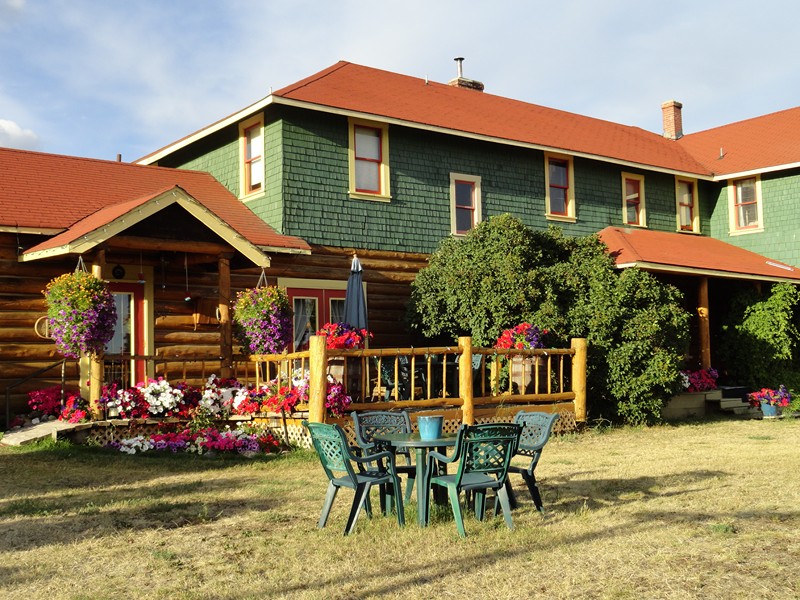 Then it was off to Riske Creek, where we were hoping to stay the night at the historic Chilcotin Lodge. I’d last stayed here a couple of times during the 1980s when we based the UBC field ecology course out of the lodge. We got to Riske Creek about 4:30 in the afternoon, and not only was there room in the Lodge—but we would have the place to ourselves! We’d timed our visit well between the busy summer period and the fall hunting season. Our host, Ria van der Klis, showed us around the various rooms—it had certainly been upgraded since the 1980s but retained that Chilcotin charm through and through. We told Ria we’d be back for supper at 7, then drove off for a quick visit to Becher’s Prairie.
Then it was off to Riske Creek, where we were hoping to stay the night at the historic Chilcotin Lodge. I’d last stayed here a couple of times during the 1980s when we based the UBC field ecology course out of the lodge. We got to Riske Creek about 4:30 in the afternoon, and not only was there room in the Lodge—but we would have the place to ourselves! We’d timed our visit well between the busy summer period and the fall hunting season. Our host, Ria van der Klis, showed us around the various rooms—it had certainly been upgraded since the 1980s but retained that Chilcotin charm through and through. We told Ria we’d be back for supper at 7, then drove off for a quick visit to Becher’s Prairie.
Taking the inconspicuous turnoff just west of the Loran station (the tower was long gone!), we were soon at Rock Lake. This lake is one of many rich water bodies on the Prairie, covered in Ruddy Ducks, Redheads, American Wigeon, Buffleheads and other waterfowl. There were still some Eared Grebes in evidence; in midsummer the big bulrush marsh at the west end of the lake is home to one of the largest grebe colonies in British Columbia. We clambered over the natural rock pile that gives the lake its name, but couldn’t find any garter snakes—this is a significant hibernaculum for the snakes, and you can often find hundreds here in the spring and fall. I imagine we were there a bit early for the fall gathering. A couple of migrant harriers coursed by, and Vesper Sparrows flew ahead of the car as we bounced along the track.
We turned south at Racetrack Lake and returned to Riske Creek from the north, stopping for a walk at Separating Lake (there are many Separating Lakes and Separation Lakes in the BC Interior–named for their use by ranchers who separated cattle from mixed herds along their shores after a summer on common range) before getting back to the lodge. Ria had prepared a fabulous dinner for us—probably the best steak I’ve ever had, and the setting further enhanced the flavour. As we ate, I noticed a black bear wandering across the grasslands to the south in the setting sun, heading for the aspen thickets along Riske Creek itself.
The following morning we had a huge Chilcotin breakfast, then drove south along the Farwell Canyon Road. Big logging trucks carrying lodgepole pine roared by in clouds of dust, but the morning haul was pretty much over as we reached the canyon. At the bridge over the Chilcotin River, Tsilhqot’in fishers were netting sockeye salmon on their way upstream to Chilko Lake, as they had been doing for millennia. We continued up the other side of the valley, then turned east onto towards the Gang Ranch. We came out onto a wide vista of grassland and the mighty Fraser far below us, driving for miles through sunny grass and scattering sparrows and larks before reaching the ranch headquarters.
Before crossing the Fraser, we turned south to the Empire Valley and the Churn Creek Protected Area. I’d visited this spot over 30 years ago with Parks Canada officials who were interested in creating a national park in the area—in the meantime it had been protected by the provincial government, which then enhanced the protected area with the purchase of the Empire Valley Ranch. This is without a doubt one of the most spectacularly scenic parts of British Columbia (which is a pretty spectacular province) and well worth a visit. Then we crossed the Fraser and returned to Highway 97 via the beautiful drive up Canoe Creek and along the Meadowlake Road. The holiday was over too quickly, but it had been a wonderful journey through some of the finest landscapes in North America, and we vowed we would be back sooner next time.
